W.H. McMullen, Ca. 1928-30 (Source: Barnes)
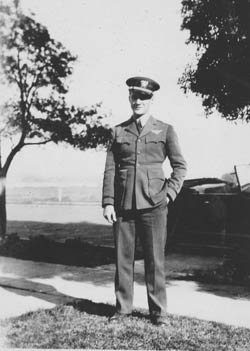 |
W.H. McMullen was born in 1909, on the cusp of the rapid societal and technological advancement leading to faster, higher and farther human flight. He was a U.S. Naval Aviator and an officer with great potential. His life was truncated on February 21, 1930 by what contemporary news accounts described as a, "spectacular aerial accident." His airplane broke up and he crashed into the water at full throttle off the Pacific coast of Panama.
Just six months earlier, on August 19, 1929, we find McMullen and nineteen of his pilot colleagues at Tucson. They were on their way from San Diego, CA to the National Air Races (NAR) at Cleveland, OH. McMullen''s responsibility at the NAR was to participate with the aerobatic team named the "Nine High Hats." Please direct your browser to McMullen's biography page at the link above for further information, links and photographs, as well as to learn the circumstances around his landing at Tucson.
W.H. McMullen, Ca. 1928-30 (Source: Barnes)
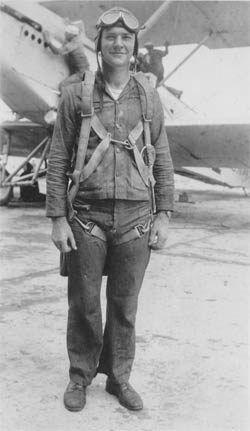 |
The commander of the entire naval entourage through Tucson and beyond was Homer Wick. The entourage consisted of the High Hats as well as support aircraft and pilots and aircraft sent cross-country to compete in other events at the NAR. Please direct your browser to Wick's biography page for tabulated hyperlinks to all nineteen men and aircraft of his fleet.
Given his short life of 21 years, 8 months and 27 days, and his short career with the Navy, McMullen left a legacy of photographs that is out of proportion to his length of life or period of service. Site visitor William Barnes (cited, right sidebar) is a nephew of pilot McMullen and he has inherited photograph albums that were carefully handed down through McMullen's siblings after his passing. He graciously shares his uncle's photograph collection with us on this Web page.
Mr. Barnes states about his uncle's photographs, "I have three scrapbooks of photos of him in the US Navy.... They show aircraft I've never seen at the Naval Air Museum including huge flying boats. Some pictures are of aircraft carriers and [airfields]. The last pictures are of the Saratoga and his unit in Panama."
Further, he states, "The Naval Museum had records of his service, but no pictures such as these." And, "I think the scrapbooks were organized as such: 1) Annotated scrapbook organized by McMullen's mother as pictures arrived. 2) Unannotated Scrapbook organized by McMullen and returned with his personal effects. 3) Scrapbook organized by mother or sister (random family pictures added; WHMc's pictures added posthumously)."
In that era of only black & white film, and of relatively primitive cameras, these photographs are premier examples of our amateur photographer's skill. As I assembled and organized his Collection for exhibition on this page, I couldn't help but think that McMullen had every intention of documenting his exciting times and activities so that he could share them and his stories later with his children and perhaps grandchildren. And nieces and nephews, too! Although he didn't get to do that directly, I'm grateful for Bill Barnes' initiative and his efforts to share them with us. My hunch is McMullen would never predict that his modest, workmanlike snapshots would be available for you to view globally on the World Wide Web.
THE WILLIAM HYDE McMULLEN NAVAL AVIATION PHOTOGRAPH COLLECTION
Below are McMullen's photographs as shared by Mr. Barnes. They are organized roughly, but not exclusively, like Mr. Barnes described the three albums above. Other than sizing and optimizing for Web presentation and download speed, the photographs are untouched in any way, preserving the folds and tears, and the exposure and developing/printing anomalies of the 80-year-old originals. McMullen's photographs provide a clear black & white window into the day-to-day life of Golden Age Navy pilots and sailors. As well, they add interesting perspective to his cross-country flight through Tucson during August, 1929.
While only a few of the photos were captioned in any meaningful way, we can date them narrowly between 1928 and 1930, which is, essentially, McMullen's only period of active service with the Navy. His duties took him from Pensacola, FL to San Diego, CA, to Cleveland, OH. He also served on the aircraft carrier U.S.S. Saratoga, and in the Panama Canal Zone. His Collection includes photos of each venue. I divided the Collection of 236 photographs into six groups to make it easier for you to work through them. Click the RED HIGHLIGHTED topics to view related photographs.
FORMAL PORTRAITS OF WILLIAM H. McMULLEN -- This section exhibits three formal portraits of McMullen in uniform.
"NINE HIGH HATS" -- This section contains 17 views of the "Nine High Hats" in action, and of McMullen and others, which appear to originate from activities around the NAR. The reason McMullen came through Tucson was that he was a flyer for the Navy's aerobatic team named the "Nine High Hats." The entire team of nine pilots and their Boeing F2B aircraft are signed into the Tucson Register on August 19th on their way to Cleveland, OH to participate in the 1929 National Air Races. A final photo shows a specially-built civil aircraft.
PHOTOGRAPHS OF LAND-BASED OPERATIONS -- Most of these 73 photographs appear to be from Pensacola, FL &/or San Diego, CA. Land-based, amphibian and seaplanes of the era are represented on the ground and in the air. Throughout, if Bureau Numbers are recognizable in the photos I cite them, even if they are not logged in the Davis-Monthan Airfield Register. Most of the people in the photographs, enlisted men and officers alike, are unidentified.
PHOTOGRAPHS OF SHIPBOARD OPERATIONS -- This fascinating group of 84 photographs was almost all taken by McMullen while aboard the U.S.S. Saratoga on a cruise to Panama, C.Z. from Naval Air Station San Diego, CA. There are photographs of many different models of aircraft (wheeled and float/amphibious), of launch and recovery of aircraft from the decks of the first U.S. aircraft carriers Saratoga and Lexington, and unique photos of the early arresting gear mechanism for capturing and stopping aircraft during landing on a carrier deck. As well, there are photographs of officers and enlisted men, most of whom are unidentified.
CIVILIAN PHOTOGRAPHS -- This group of 35 photographs shows McMullen and his family and acquaintances mostly at leisure or in sightseeing venues.
PHOTOGRAPHS IN PANAMA -- This group of 24 photographs exhibits views of Panama, including McMullen and his fellow pilots, mostly as sightseeing snapshots. As well as being the last photos in his Collection, they are among the last ones McMullen ever took.
---o0o---
---o0o--- ---o0o---
FORMAL PORTRAITS OF WILLIAM H. McMULLEN -- Five views.
W.H. McMullen, Date & Location Unknown, Ca. 1928-30 (Source: Barnes)
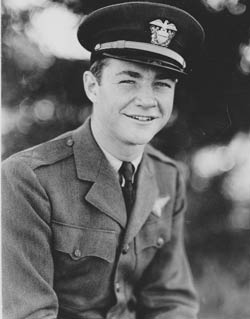 |
While the exact date of these portraits is unknown, they are probably earlier than later in his short career with the Navy. The originals show freckles, clear skin and have all the characteristics of a boy rather than an experienced naval aviator. Regardless of the date, he would be no older than 21 in these photos.
There are additional informal portraits of McMullen in the other segments of his Collection (see the three at the top of the page, for example), but these three, and the one above in the left sidebar, appear to have been posed and taken by a professional photographer.
W.H. McMullen, Date & Location Unknown, Ca. 1928-30 (Source: Barnes)
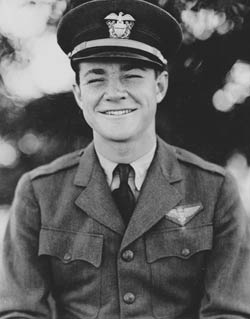 |
W.H. McMullen, Date & Location Unknown, Ca. 1928-30 (Source: Barnes)
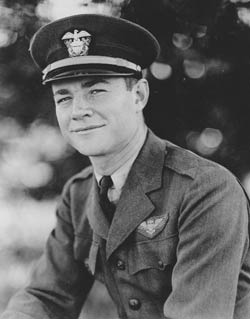 |
Of his nineteen peers who landed with him at Tucson, an unusually high percentage went on to earn flag ranks and highly responsible commands in WWII and beyond. There is every reason to believe that, had he lived, McMullen would have followed a similar pathway to achievement with the Navy.
BACK TO TOP
---o0o---
---o0o--- ---o0o---
"NINE HIGH HATS" -- Seventeen views.
The first eight are views of the "Nine High Hats" in action. A feature of the group's performances was the fact that they took off, executed aerobatics and landed with their wings attached by long ropes.
"Nine High Hats," Ca. 1929 (Source: Barnes)
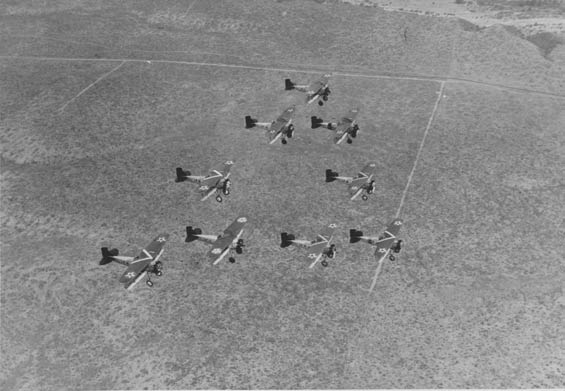 |
They are tied together in the next three views. Notice the ropes have markers on them for visibility.
"Nine High Hats," Ca. 1929 (Source: Barnes)
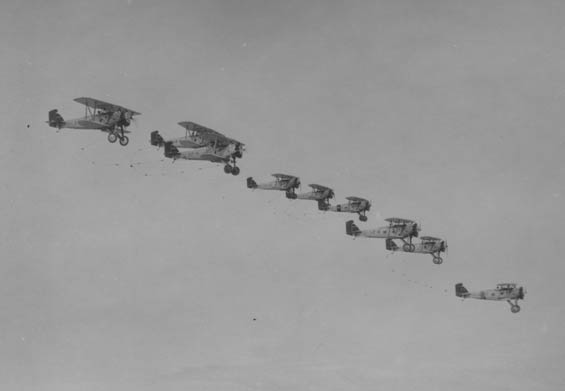 |
I know of no aerobatic team today that performs with their wings attached in any manner.
"Nine High Hats," Ca. 1929 (Source: Barnes)
 |
"Nine High Hats," Ca. 1929 (Source: Barnes)
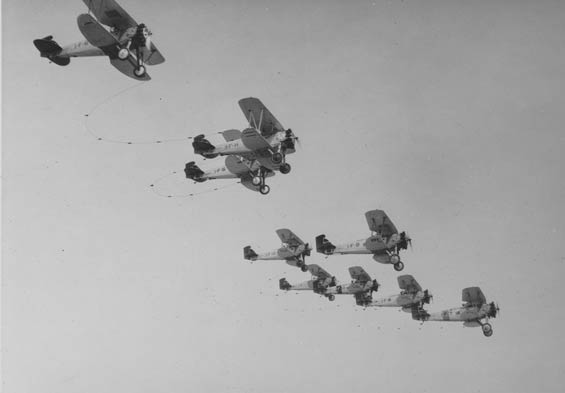 |
Below, none of the Bureau Numbers of the aircraft are readable, but the squadron numbers run in close order. The location is unknown. In this photo, there are no ropes attaching their wings.
Seven of the "Nine High Hats," Ca. 1929 (Source: Barnes)
 |
Below, two scans of contemporary, undated news articles featuring the High Hats.
"Nine High Hats," Undated News, Ca. 1929 (Source: Barnes)
 |
In both of these news photos the lines connecting the wingtips are visible. Below, the airplane at far right has his line disconnected from his team mate and trailing.
"Nine High Hats," Undated News, Ca. 1929 (Source: Barnes)
 |
Below, a news photograph and caption describing the action at Cleveland. The date of this photo is ca. August 24-September 2, 1929.
"Nine High Hats," Ca. August 24-September 2, 1929 (Source: Barnes)
 |
Two numbers are identifiable in the photo. The nearest airplane is A-7445, which is not signed in the Register. The second one back is A-7444, which appears in the Register on page 112. It was flown by Jackson R. Tate. Below, the caption for the photo above. Given that the photo is datelined San Diego and is cited as being taken, "just after the takeoff for the National Air Races," we can date this photo to the morning of August 19, 1929.
"Nine High Hats," Ca. August 24-September 2, 1929, Caption (Source: Barnes)
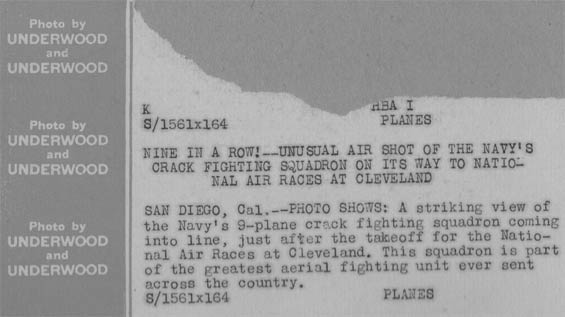 |
Below, a photograph of McMullen with another pilot identified as Vic Randecker. The location is identified as Grosse Ile Naval Air Station. Given that the base was commissioned on September 7, 1929 as "United States Naval Reserve Aviation Base, Grosse Ile, MI," this is a very early photo of the area. The airplane they stand in front of is a Boeing F2B, A-7438, which we can safely guess was the one McMullen flew through Tucson. A-7438 is not signed in the Register elsewhere by McMullen or any other pilot.
W.H. McMullen with Vic Randecker, August-September, 1929 (Source: Barnes)
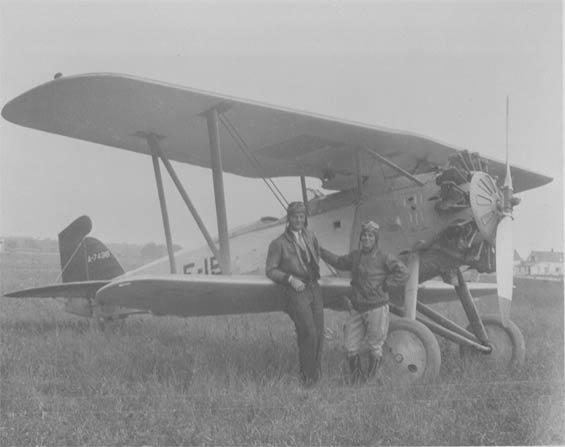 |
Caption, Back of Photograph Above (Source: Barnes)
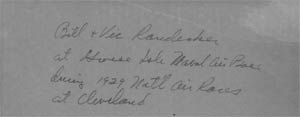 |
Randecker (b. 12/24/1905, d. 01/06/1977, U.S. Navy, Captain) would later become involved in the aeronautical engineering program at the Alabama Polytechnic Institute. He would develop curricula in airplane design, maintenance and operation of airplanes, and the business of commercial aviation.
Below, another photograph of Randecker (L) and McMullen. This appears to be the same airplane, taken at the same place and time.
Vic Randecker & W.H. McMullen, Cleveland, OH, August-September, 1929 (Source: Barnes)
 |
Another photograph of McMullen in A-7438 with a different officer talking to him. The engine is running and another, unidentified aircraft is at the rear.
W.H. McMullen, Cleveland, OH, August-September, 1929 (Source: Barnes)
 |
Another photo of McMullen in his cockpit. The photographer moved the camera.
W.H. McMullen, Cleveland, OH, August-September, 1929 (Source: Barnes)
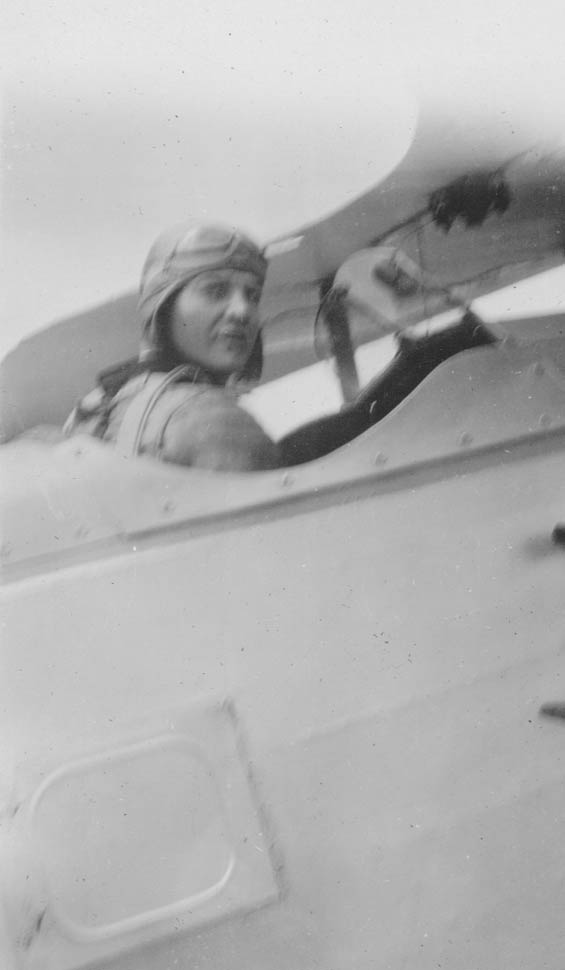 |
Next, a photograph of McMullen standing with an unidentified gentleman in the shadow of a Boeing wing. McMullen's Boeing, A-7438, stands at right with items resting on the horizontal stabilizer.
McMullen & Gentleman Among Boeings, Ca. 1928-30 (Source: Barnes)
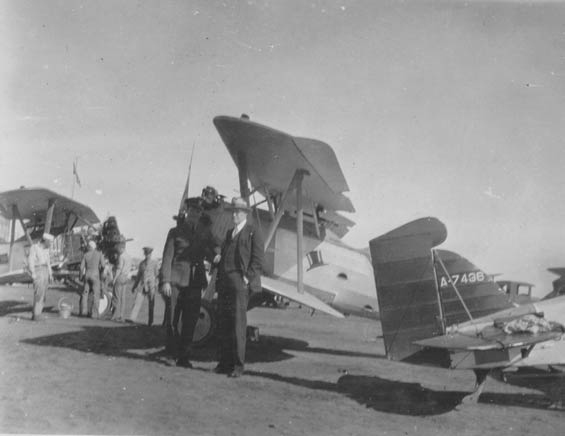 |
Below, W.H. McMullen stands behind a High Hats Boeing with six people standing in front. The gentleman on the left is McMullen's brother, Wesley (d. 1983), shown in the first image in the CIVILIAN PHOTOGRAPHS section, below. The woman next to Wesley is sister Mary McMullen, then Ruth Hyde McMullen, William and Wesley's mother. The gentleman 3rd from right resembles the one standing with McMullen in the photo above. The others are unidentified.
McMullen (Rear) With Others, Ca. 1928-30 (Source: Barnes)
 |
Below, five of the same people in front of the same airplane. The gentleman at far left resembles McMullen's brother even more in profile.
Six People in Front of Boeing, Ca. 1928-30 (Source: Barnes)
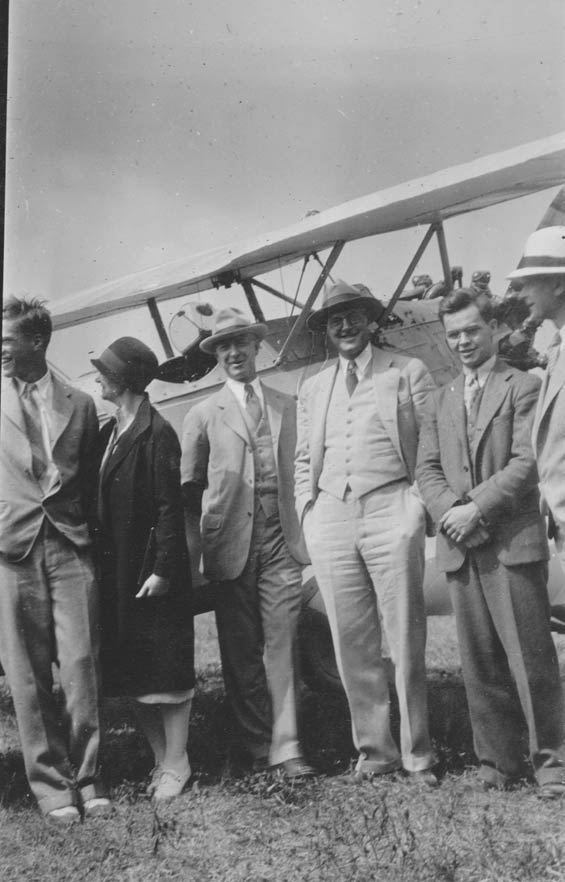 |
Next, a group in front of the same airplane identified by Mr. Barnes as follows, left to right: Ralph William McMullen (father), Ruth Hyde McMullen (mother), two unknown females (sister Mary McMullen is much taller than her mother and therefore not in the picture), Wesley McMullen, William Hyde McMullen, unknown officer.
McMullen Family and Others, Ca. August, 1929 (Source: Barnes)
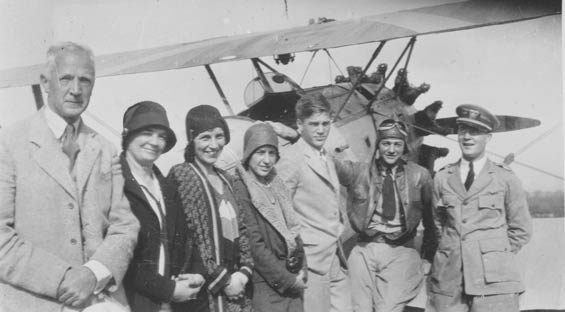 |
Below, a photograph that might have been taken by McMullen on the west coast, or in Cleveland while he was there for the NAR.
Cal Tech Merrill-Type Biplane, C.I.T.-9, Ca. 1928-30 (Source: Barnes)
 |
The photograph is of NX5665, known as the Cal Tech Merrill-Type Biplane, CIT-9. Although the registration number cannot be read easily, upon magnification "C.I.T. 9" and "Merrill-Type" can be inferred from the fuselage. Below, left is another photograph (from Wikimedia stream online) of the airplane with identification marks readable. Register pilot Amelia Earhart stands by the aircraft.
Cal Tech Merrill-Type Biplane, C.I.T.-9, Ca. 1928-30 (Source: Wikimedia)
 |
The airplane was built ca. 1925 and was billed as the "CIT-9 Safety Plane." It was designed by Albert Adams Merrill, an instructor in aeronautics at Cal Tech. The engine is a 45HP Kinner 5-cylinder. This is an interesting, "outside the box" design, and it is easy to understand McMullen's interest in it. Note that neither upper or lower wing are attached solidly to the fuselage. This is because the wings, under pilot control, could be moved in relation to one another from no stagger to extreme stagger. This movement allowed the airplane to maintain its fuselage horizontal, while changing angle of attack with the wings alone. Photographs illustrating the limits of wing movement are at the link below.
According to Merrill, "'If we move the stabilizer forward, progressively increasing its size until it becomes a lower wing located somewhat behind the upper wing, i.e., with `stagger' and angularity to the upper wing, i.e., `decalage' we have a ship that is equally stable in any position.'
"The two wings of the aircraft were not integrated with the fuselage, and the entire biplane wing structure could be tilted up or down by the pilot to a maximum angle of 14 degrees. Pitch control of the airplane was thus obtained by altering the angle of the wings relative to the fuselage rather than by altering the angle of the entire fuselage relative to the ground as is generally done with the elevator. Both wings moved as a unit; no alteration of the relation of upper and lower wings was possible. By limiting the lower and upper limits of wing travel with mechanical stops, safe flight was more or less assured within the range of practical flying."
Merrill further states, "'So long as you fly within these limits nothing can stall or nose the machine and this means safety!' If the occasion arose when it was necessary to exceed the limits of wing movement, as in an emergency or to perform aerobatics, an elevator was available for control. There was, however, no fixed horizontal tail surface."
BACK TO TOP
---o0o---
---o0o--- ---o0o---
PHOTOGRAPHS OF LAND-BASED OPERATIONS -- Seventy-three views.
Below, a view to the northwest of North Island, San Diego, CA. This was what McMullen saw as he approached his landing area at the Naval Air Station, San Diego. The point of land at the top of this photograph is Point Loma.
North Island, San Diego, CA, Ca. 1929 (Source: Barnes)
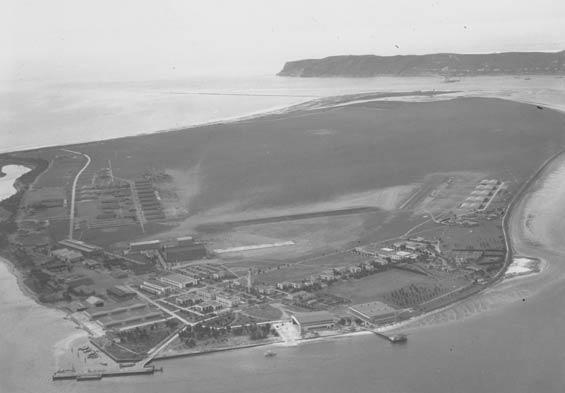 |
Below, the next few photographs show McMullen's squadron on the ground. This was about a year before his visit at Tucson. About 17 aircraft can be counted. The location is probably San Diego.
McMullen's Squadron on the Ground, August 30, 1928 (Source: Barnes)
 |
Below, the dated caption on the back of the photo above. The film development and printing date was August 30, 1928. We don't know when the photograph was actually taken.
McMullen's Squadron on the Ground, August 30, 1928, Caption (Source: Barnes)
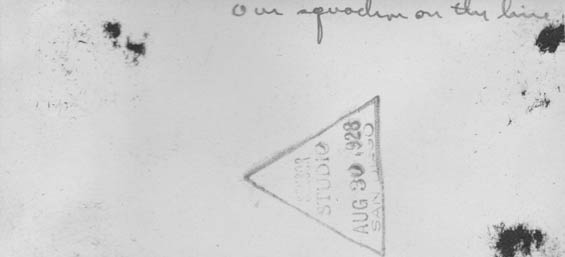 |
Below, an F2B taxiing in front of a rank of seven aircraft that appear to be Curtiss Hawk models. This appears to be a companion photo to the one above, with the Boeings absent the line, leaving the Curtiss. Note the legs of a ground handler below the fuselage. His heels appear to be propared to dig into the soil to help turn the airplane. Note also the plume of dirt behind the tail skid of the F2B.
Unidentified F2B, Ca. 1928-30 (Source: Barnes)
 |
Below, a rank of unidentified aircraft (Vought UO-2s?).
Unidentified Aircraft in a Row, Ca. 1928-30 (Source: Barnes)
 |
Below is an aerial view of aircraft amassed on the ground at North Island, San Diego, CA (view is to the northwest). Compare with the first aerial photograph, above.
North Island, San Diego, CA, Ca. 1929 (Source: Barnes)
 |
Next, a similar view to above, but with the camera probably pointed a little to the left.
North Island, San Diego, CA, Ca. 1929 (Source: Barnes)
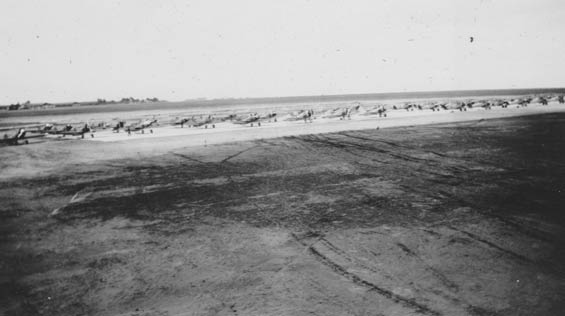 |
Below, an unidentified Boeing F2B; date and location unidentified.
Unidentified F2B, Ca. 1928-30 (Source: Barnes)
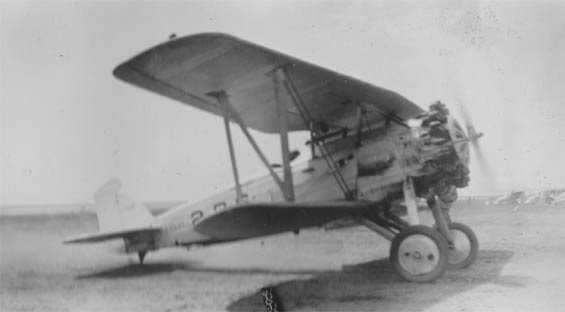 |
Below, Vought O2U on a ramp warming up for departure. The duck insignia on the fuselage is Scouting One's cartoon bird logo. The duck wore a leather helmet and goggles, and the bird's feet were aircraft pontoons with wheels, signifying their use of amphibian versions of the Corsair. Date and location unidentified, but probably North Island.
Unidentified Vought, Date & Location Unknown, Ca. 1928-30 (Source: Barnes)
 |
Next, a photograph probably taken slightly after the one above. Notice the airplane taxiing at right with ground handlers into the screen appears to be a little farther along.
Unidentified Vought, Date & Location Unknown, Ca. 1928-30 (Source: Barnes)
 |
Below, yet another view of aircraft on the ramp, probably at North Island.
Unidentified Aircraft, Date & Location Unknown, Ca. 1928-30 (Source: Barnes)
 |
Below, unidentified F2Bs undergoing group maintenance. Location unknown.
Unidentified F2Bs. Location Unknown, Ca. 1928-30 (Source: Barnes)
 |
Below, a Boeing F3B-1, A-7676, date and location unidentified. This model came to the Navy during 1927. This Boeing is from VF-2 "Flying Chiefs," the only Navy Squadron at that time with most of its pilots from enlisted ranks (Chief Petty Officers, hence the name), who were given the new rank of "Naval Aviation Pilot."
Boeing F3B-1, Ca. 1928-30 (Source: Barnes)
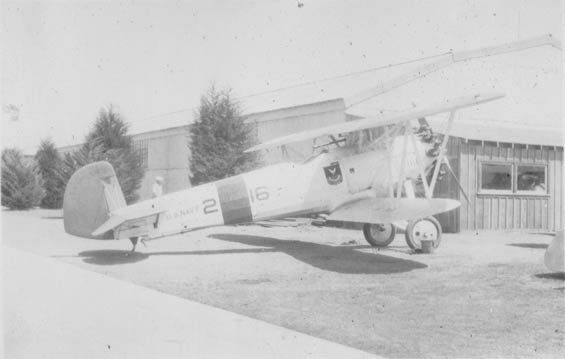 |
Below, McMullen in the cockpit of his Boeing FB2. Notice the ground handler with rolled dungarees smiling at the camera, and the wheel chocks still in place, waiting to be removed by the ground handlers pulling the rope. The location might be the 1929 NAR in Cleveland, OH.
W.H. McMullen in Cockpit, Ca. 1929-30 (Source: Barnes)
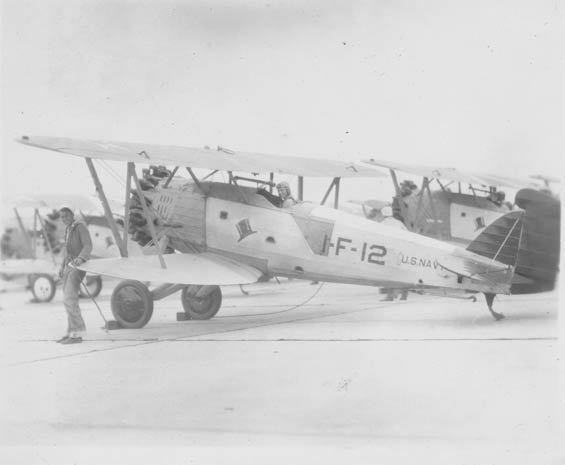 |
Below, another view of McMullen in the cockpit. The same ground handlers hold the ropes. The engine is running. This could be preparation for a "Nine High Hats" performance or practice.
W.H. McMullen in Cockpit, Ca. 1929-30
(Source: Barnes)
 |
Below, a clear profile of Vought O2U-2 Corsair, A-8095 (not a Register airplane). The Scarff ring for the gunner's rear cockpit is clearly visible. The five-stranded wire visible running from the top to bottom wing is a radio antenna. Many of the Corsairs pictured below have this antenna installed, or the mounting blocks for the wires are installed in readiness to receive the antenna wire and radio if a radio set is called for. The radio was for direction finding.
Vought O2U-2 Corsair, Ca. 1928-30 (Source: Barnes)
 |
McMullen's notation on this photo follows. He appears to have affection for the airplane.
Vought O2U-2 Corsair, Caption, Ca. 1928-30 (Source: Barnes)
 |
Below, another view of A-8095 with McMullen on the ramp.
W.H. McMullen With Vought Corsair (Source: Barnes)
 |
McMullen's notation on this photo follows.
Vought O2U-2 Corsair, Caption, Ca. 1928-30 (Source: Barnes)
 |
Below, an elevated view of aircraft on the ramp (perhaps standing in the cockpit of A-8095?). Can anyone IDENTIFY the location? Might it be North Island, San Diego with a view toward the northwest? Notice the double row of buildings at the right side of the photo and compare them with the five double rows of buildings at the far right of the aerial view of North Island, above.
Aircraft on Ramp, Location Unknown, Ca. 1928-30 (Source: Barnes)
 |
A cockpit view. The funnel-shaped device at lower right is either a gosport tube for speaking to the gunner, or a relief tube. Does anyone KNOW?
Vought Corsair Cockpit Interior, Ca. 1928-30 (Source: Barnes)
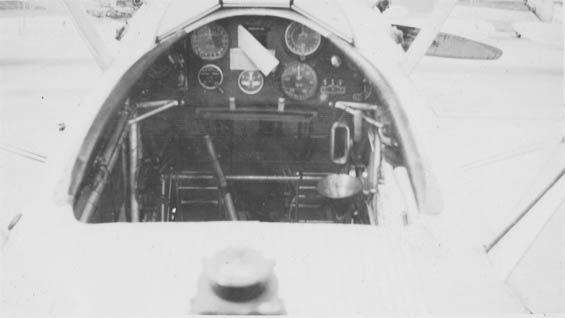 |
Next, pilot Charles Dolson and Vought. Pilot Dolson was identified by his daughter on May 12, 2014. See other photos of Dolson, below.
Charles Dolson & Aircraft, Ca. 1928-30 (Source: Barnes)
 |
Unidentified pilot with a Boeing FB-5, Boeing's first naval fighter with a Packard V-12 engine.
Unidentified Pilot & Boeing FB-5, Ca. 1928-30 (Source: Barnes)
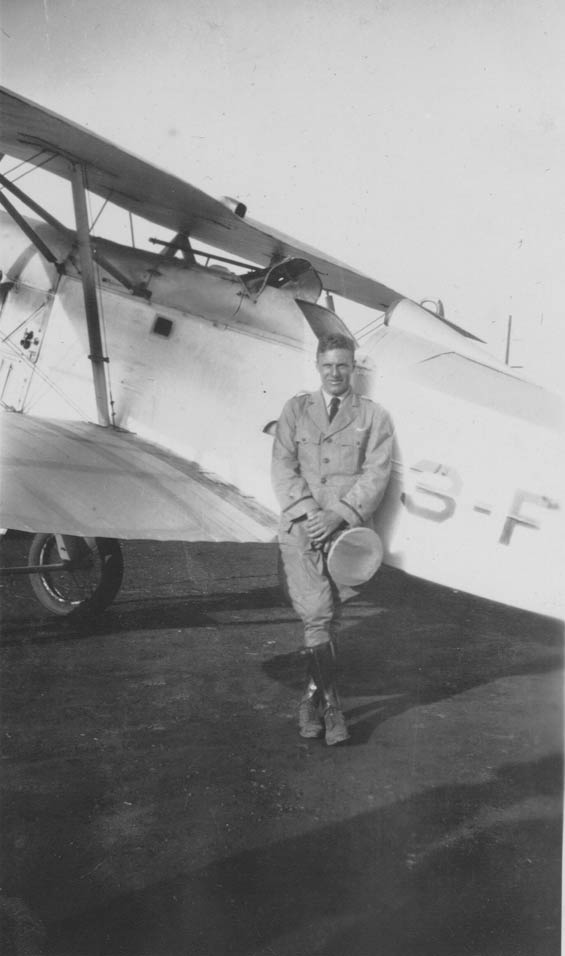 |
Below are several photographs apparently taken at the same place. The circumstance appears to be an exhibition of Navy aircraft, specifically a fleet of Curtiss N2C-1 Fledglings. The location, date and people are unidentified. The nearest airplane is identifiable as A-8038 (not a Register airplane). Rudders of two other Fledglings are behind the automobile.
A Group of Curtiss N2C-1 Fledgelings, Ca. 1928-30 (Source: Barnes)
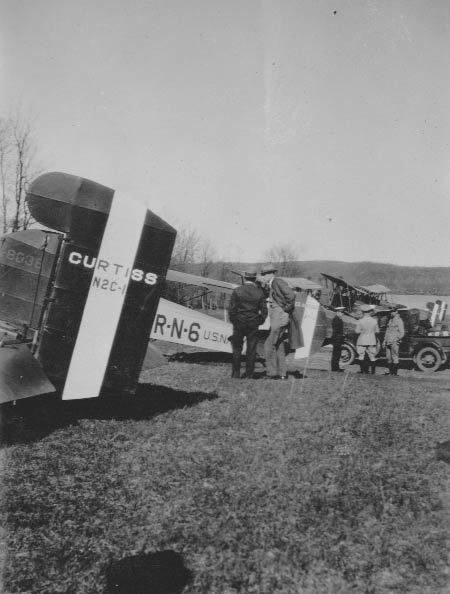 |
The second photo shows A-8038 with pilot and observer in their cockpits.
Curtiss N2C-1 Fledgling, Ca. 1928-30 (Source: Barnes)
 |
A view of the proceedings with an automobile bearing Michigan license plate. I was unable to see a date on the plate. It is not clear if the officer is McMullen, but he looks somewhat like him.
Air Event, Ca. 1928-30 (Source: Barnes)
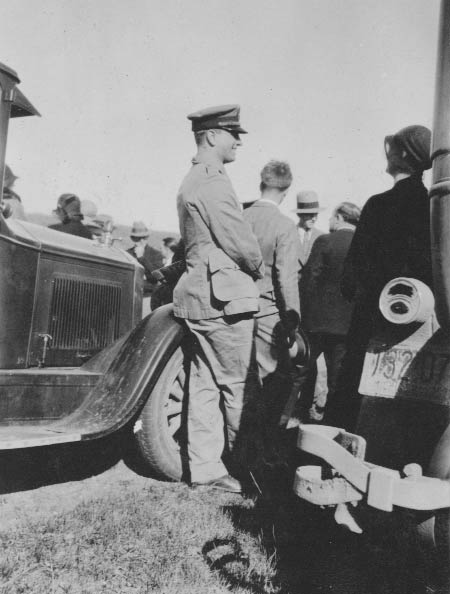 |
We could postulate that these photos document more of the activities on the ground at Gross Ile, MI that was cited in the caption of the photo farther above of McMullen and Randecker. Further evidence is on Wick's biography page where a citation from the Bureau of Aeronautics Newsletter for September 11, 1929, Page 12, enumerates three Curtiss Fledglings sent by the Great Lakes Naval Air Station enroute to the NAR. We could further postulate that the date of the photographs is somewhere near Labor Day.
Below, L to R, unknown naval officer, Ralph William McMullen, Mary McMullen and Wesley McMullen. They stand in front of a Curtiss Fledgling.
Four Unidentified People, Ca. 1928-30 (Source: Barnes)
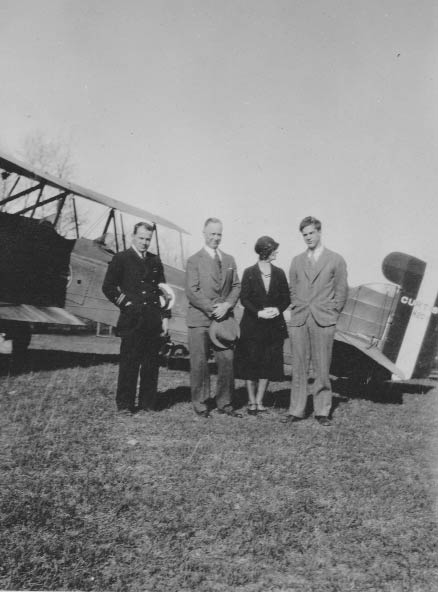 |
Below, six people standing in front of the same Fledgling. Four of them are also in the photo above. They are identified (L-R) as unknown naval officer, unknown gentleman, Ruth Hyde McMullen, Mary McMullen, Wesley McMullen, unknown youth.
Six Unidentified People, Ca. 1928-30 (Source: Barnes)
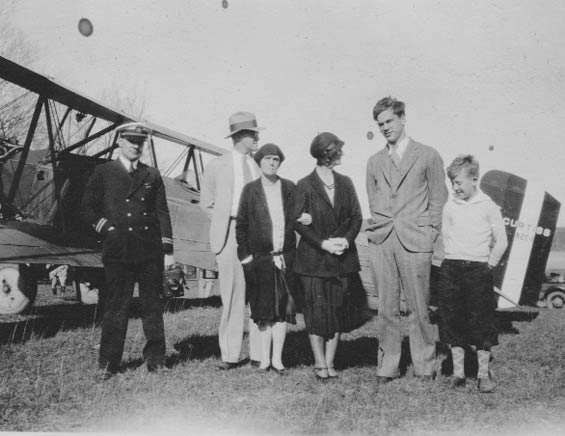 |
Below, at left, Ralph William McMullen with large format box camera; the woman is Mary McMullen (sister) among a group of unidentified officers. None of the officers appear to be McMullen.
Eight Unidentified People, Ca. 1928-30 (Source: Barnes)
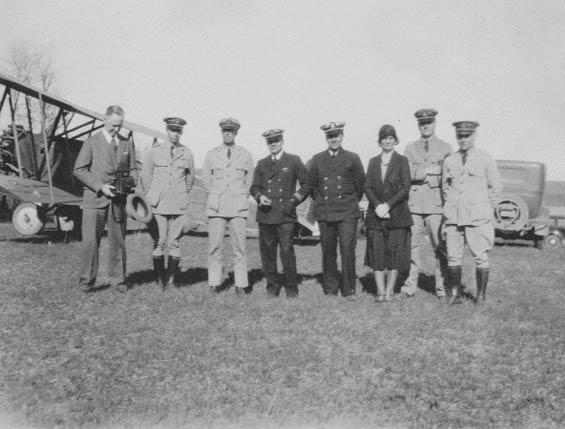 |
Next, six unidentified people looking skyward, probably watching airplanes.
Unidentified People Looking Skyward, Date & Location Unknown, Ca. 1928-30 (Source: Barnes)
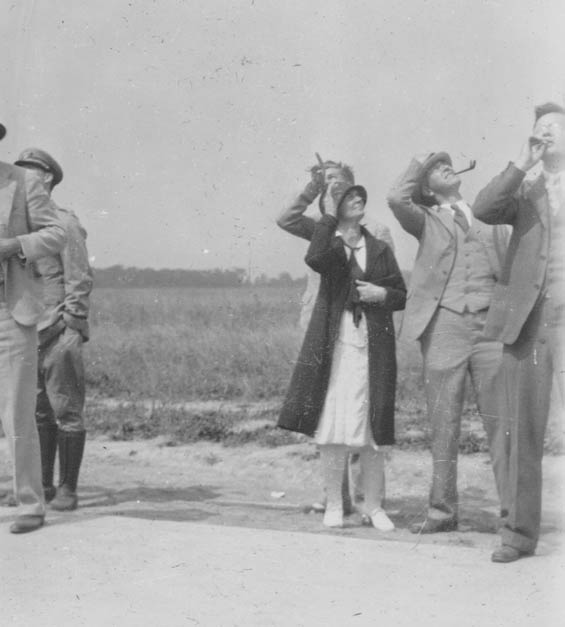 |
Taken at various, unidentified times and locations, the following thirteen photographs show aerial views of terrain and aircraft, mostly Vought Corsairs flying in formation. The wing structures visible in some of the photos are of Vought Corsairs. The first appears to be an unidentified mountainous area. Why McMullen snapped these photos is anybody's guess. Note the aircraft structure in the lower right corner of this photo.
Unidentified Mountainous Area, Ca. 1928-30 (Source: Barnes)
 |
Below, three photos that appear to have been taken in close order. It is not clear what the subject is, other than dry lake desert.
Unidentified Location 1, Ca. 1928-30 (Source: Barnes)
 |
Below, the five stranded wire radio antenna is just visible outside the rear upright of the "N" strut in this and the next photo. Another multistrand wire appears at the far left of the photo below. Perhaps it is tuned to a different frequency, selectable by a switch in the cockpit.
Unidentified Location 2, Ca. 1928-30 (Source: Barnes)
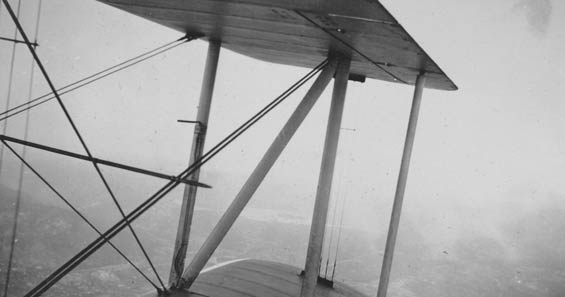 |
If you can identify these locations, please let me KNOW.
Unidentified Location 3, Ca. 1928-30 (Source: Barnes)
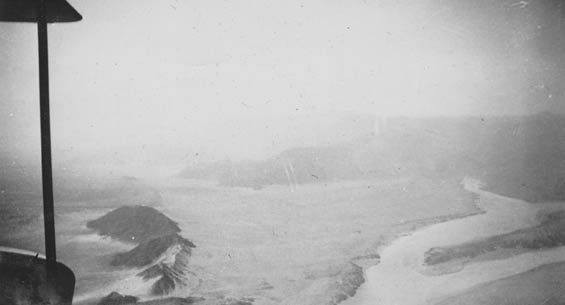 |
Below, what looks like agricultural land on the shore of the Salton Sea.
Salton , Ca. 1928-30 (Source: Barnes)
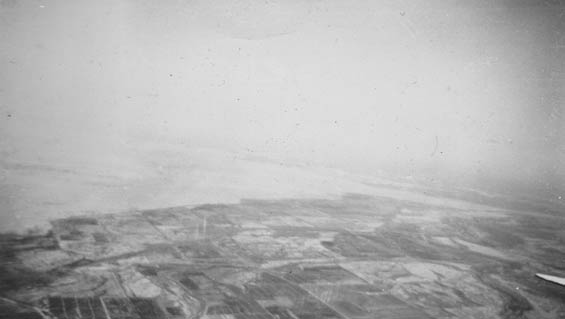 |
Next, a forest fire at 11:00.
Forest Fire, Ca. 1928-30 (Source: Barnes)
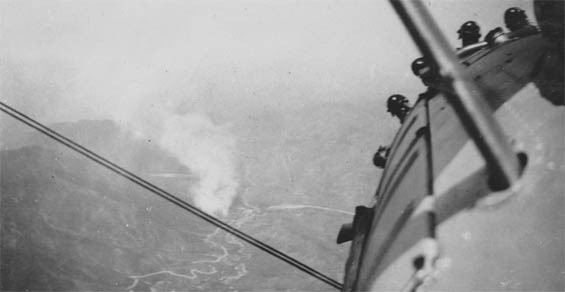 |
Next, the same fire moved toward 9:30 with reference to the direction of flight.
Forest Fire, Ca. 1928-30 (Source: Barnes)
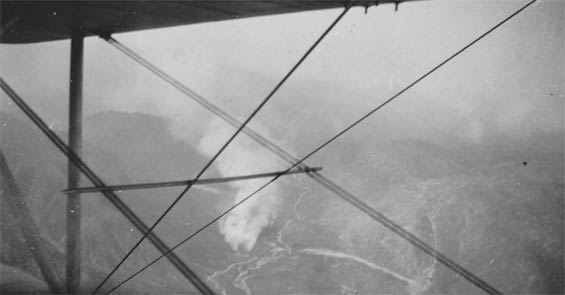 |
Below, Corsairs in formation.
Corsairs in Formation, Ca. 1928-30 (Source: Barnes)
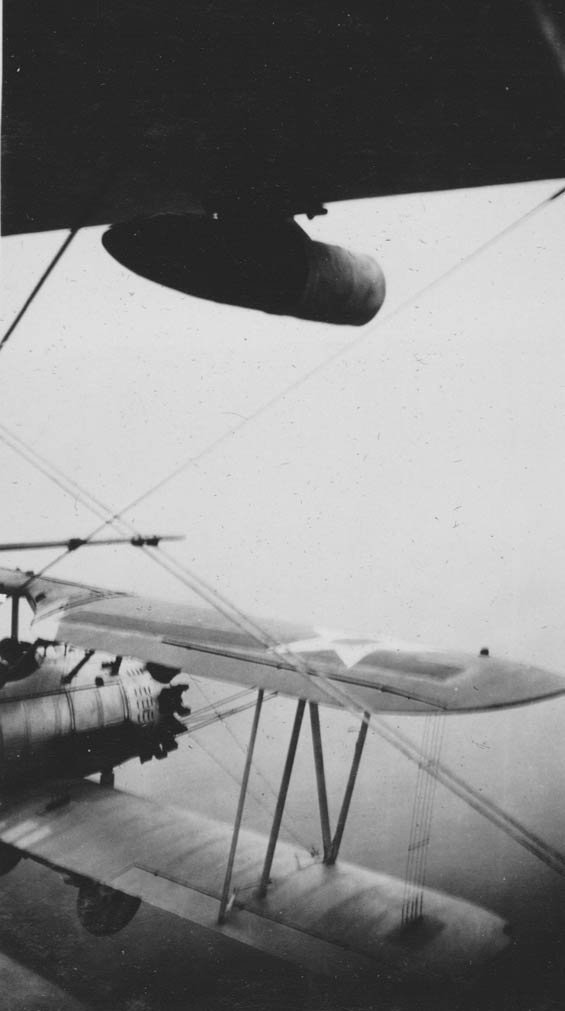 |
The caption for the photograph above, describing the circumstances of the shot and some of the visible hardware.
Corsairs in Formation, Caption, Ca. 1928-30 (Source: Barnes)
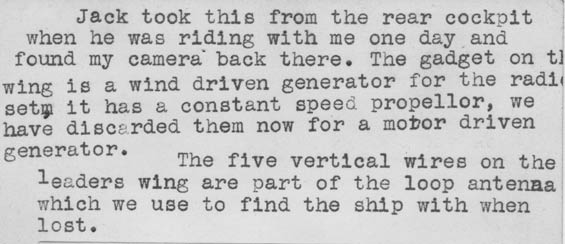 |
Below, another view of a Corsair in formation.
Corsairs in Formation, Ca. 1928-30 (Source: Barnes)
 |
Caption for the photograph above.
Corsairs in Formation, Caption, Ca. 1928-30 (Source: Barnes)
 |
Finally, two photographs of Corsairs in formation. Below, nine Corsairs photographed laterally over coastline with fairly good surf blowing in at windward. There is a lighthouse on the point of land which fairly clearly identifies the coast as Point Loma, just northwest of the North Island Navy facility.
Nine Corsairs in Formation, Ca. 1928-30 (Source: Barnes)
 |
Six Corsairs in formation captured from directly overhead. This coast is unidentified.
From Overhead, Six Corsairs in Formation, Ca. 1928-30 (Source: Barnes)
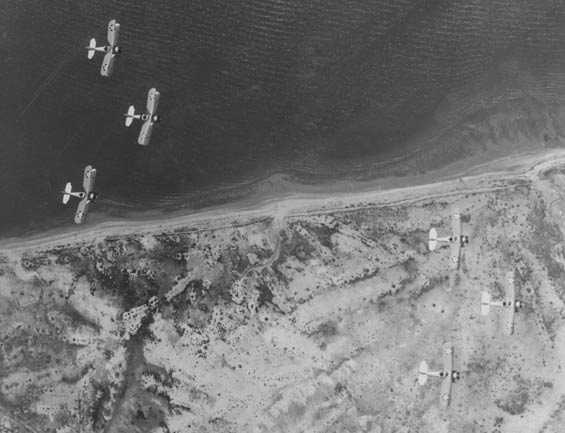 |
Below, Kewpie Kimpler's Corsair.
Kewpie Kimpler's Corsair, Ca. 1928-30 (Source: Barnes)
 |
The simple caption for above.
Kewpie Kimpler's Corsair, Caption, Ca. 1928-30 (Source: Barnes)
 |
Below, this is either a head shot, blurred, taken as if from arms length with the camera pointed at the photographer, or a photograph of an unidentified back seater taken by the pilot.
Head Shot, Ca. 1928-30 (Source: Barnes)
 |
Below, several views of aircraft and seamen taken mostly at a land base. The first is of a Curtiss N-9. The fuselage lettering "GL" denotes Great Lakes Naval Air Station, Glenview, Illinois.
Unidentified Pontoon Aircraft, Ca. 1928-30 (Source: Barnes)
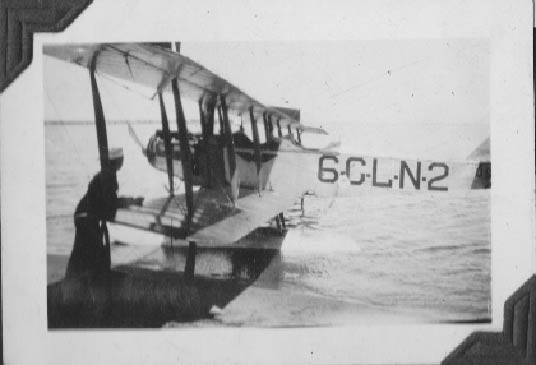 |
Below, a Vought UO-1. A photo of what appears to be the same airplane is online at the San Diego Aerospace Museum's Flickr stream.
Unidentified Pontoon Aircraft, Ca. 1928-30 (Source: Barnes)
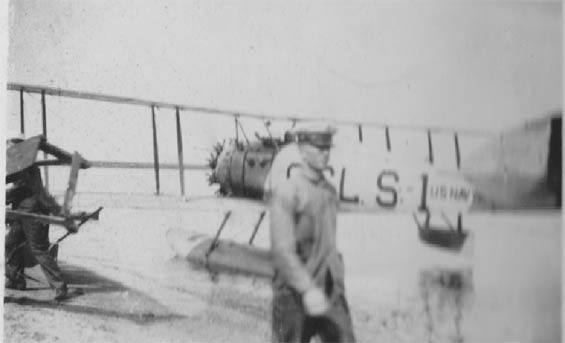 |
Another pontoon aircraft, below, is a Curtiss HS-2L. This REFERENCE discusses HS-2Ls on pages 109-111. The HS-2L was the standard Navy single-engine patrol boat until 1926. This airplane was stationed at Hampton Roads, VA. HS-2Ls were used for survey planes in Canada until the early 1930s.
Curtiss HS-2L, Ca. 1928-30 (Source: Barnes)
 |
Below, an HS-2L being launched or retrieved. This was a large aircraft, with a wingspan of 74+ feet. It was a WWI aircraft, very obsolete by 1928.
Curtiss HS-2L, Ca. 1928-30 (Source: Barnes)
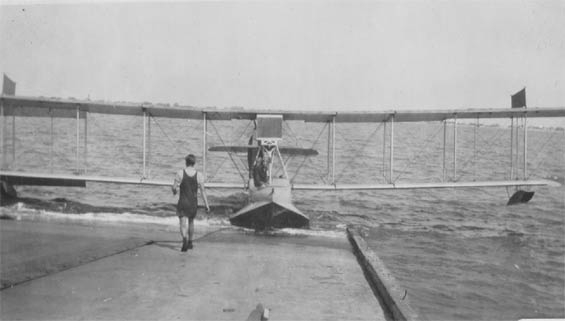 |
Below, a pontoon-equipped aircraft on a transport dolly. The engine cowling is off and the engine is running. This airplane is a Martin T3M, the Navy's main torpedo plane of the late '20s.
Martin T3M on Pontoons , Ca. 1928-30 (Source: Barnes)
 |
Below, five Martin T3M-2 aircraft on wheels. Location unknown, but probably Pensacola.
Five Martin T3M-2 Aircraft, Ca. 1928-30 (Source: Barnes)
 |
Below are two photographs of a Martin T3M-2 airplane with McMullen in the views. In the first group picture, McMullen is fourth from the left standing on the ground. The Martin was a large airplane.
McMullen (4th From Left on the Ground) and Other Unidentified Airmen, Ca. 1928-30 (Source: Barnes)
 |
Below, McMullen is second from left in the middle row. This appears to be the same group of men and the same airplane as above. If you can identify any of the others, please let me KNOW who they are.
McMullen (2nd From Left) and Other Unidentified Airmen, Ca. 1928-30 (Source: Barnes)
 |
Below, McMullen stands solo dressed as above, standing in front of what is probably the same airplane. These photos were probably taken the same day.
W.H. McMullen in Flight Gear, Ca. 1928-30 (Source: Barnes)
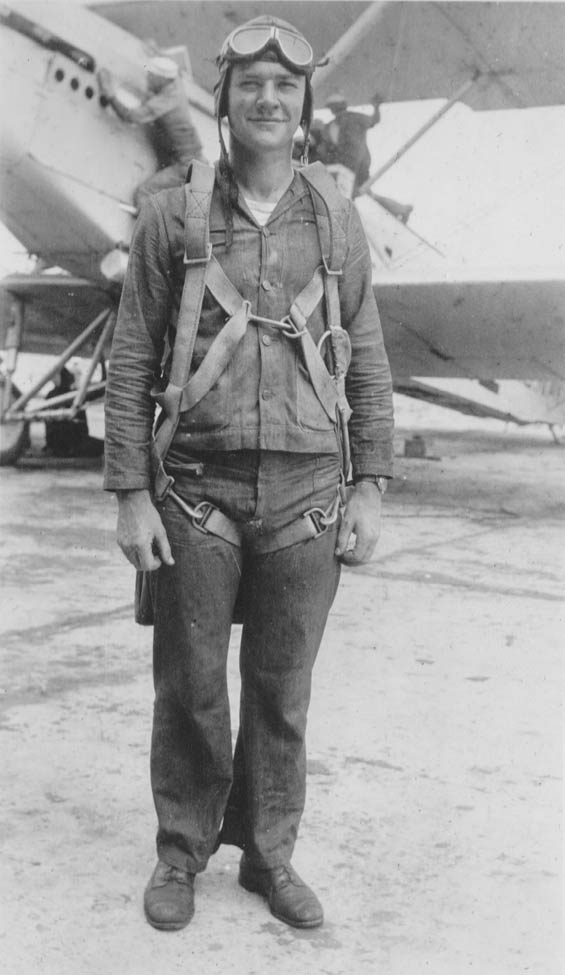 |
And again. The Felix insignia again identifies the airplane as a Boeing F3B-1 belonging to Bombing Squadron Two (VB-2B).
Unidentified Officer, Ca. 1928-30 (Source: Barnes)
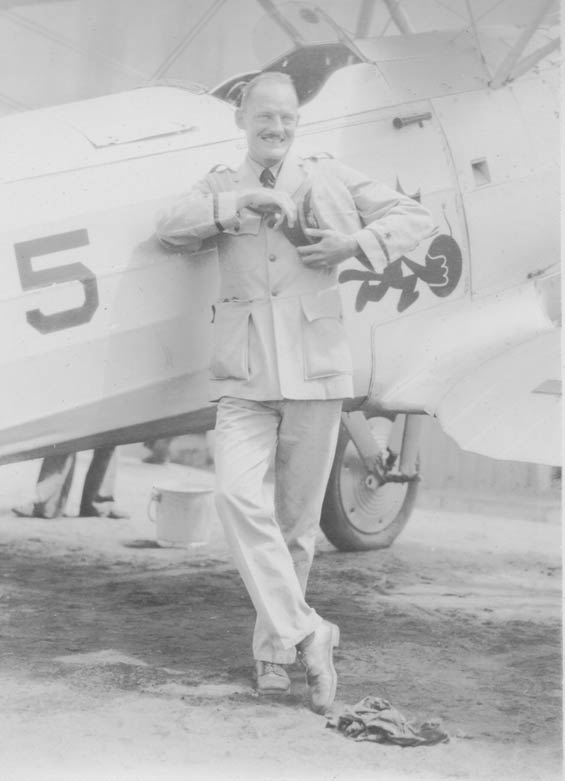 |
Below, Charles Dolson standing by the same airplane. The bucket and person standing behind the airplane above are missing in the photo below. A bicycle enters the photo below, just behind the landing gear wheel..
Charles Dolson, Ca. 1928-30 (Source: Barnes)
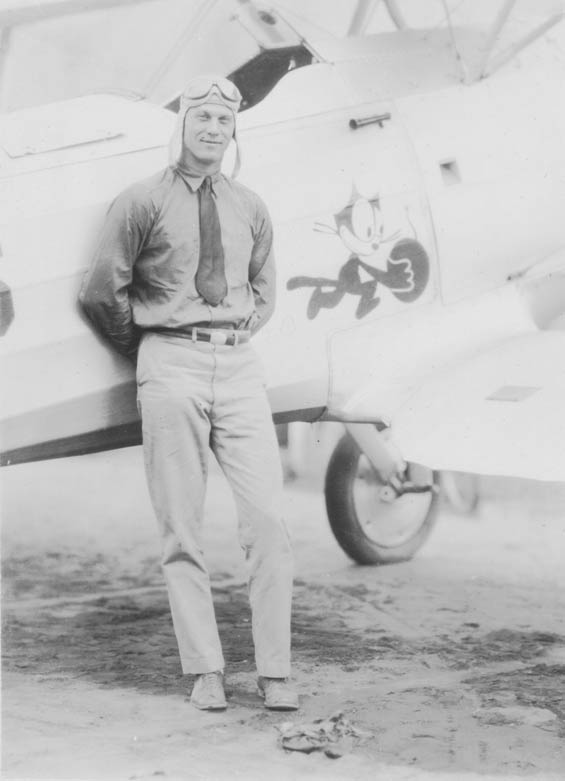 |
Below, another identified officer standing by the same airplane. Notice the rag lying on the ground.
Unidentified Officer, Ca. 1928-30 (Source: Barnes)
 |
Below, an officer identified as Bud Bassett, who is documented as coming over to the carrier from the Lexington just for lunch. He is not a member of McMullen's squadron.
U.S.S. Lexington Officer Bud Bassett, Ca. 1928-30 (Source: Barnes)
 |
The caption penciled on the back of the photograph above.
U.S.S. Lexington Officer, Caption, Ca. 1928-30 (Source: Barnes)
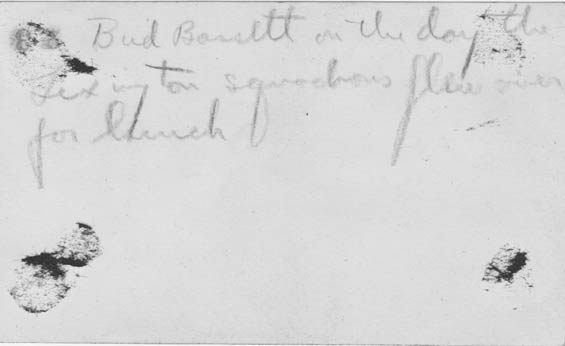 |
Next, two men in an office. They both appear to be reading books. There is nothing I could find in this photo that identifies the place or the reason why the men are there. The furnishings are typical of offices of the era: heavy oak desk and file cabinet, wooden desk chair, and heavy metal trash can. The books on the desk appear to be reference volumes. Notice the hot water or steam radiator. The photos hang by wires from a cove strip near the ceiling, suggesting that the walls are plaster.
Two Unidentified Men in an Office, Ca. 1928-30 (Source: Barnes)
 |
Below, McMullen is at left with three other officers in blue uniforms with swords. Mr. Barnes identifies the others (L-R) as Frank Diffley (who later became a captain), Henry ? and Frank Kern.
McMullen, Left, With Three Officers (Source: Barnes)
 |
Below, another view of the same officers taken simultaneously with the one above. The caption penned by McMullen on the border reads, "Just after inspection. Taken in patio in center of officer's quarters."
McMullen, Left, With Three Officers (Source: Barnes)
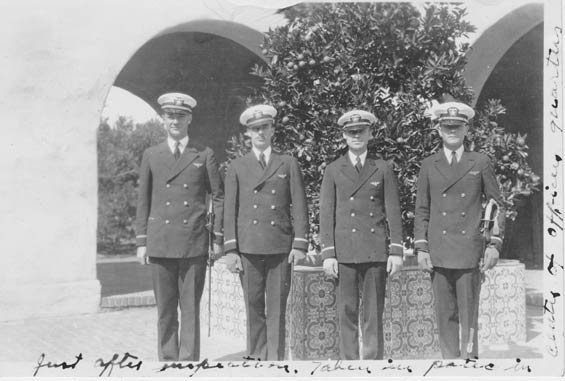 |
Next, McMullen appears to be fourth from right in this group photograph with nine other officers.
McMullen, 4th From Right, With Nine Unidentified Officers (Source: Barnes)
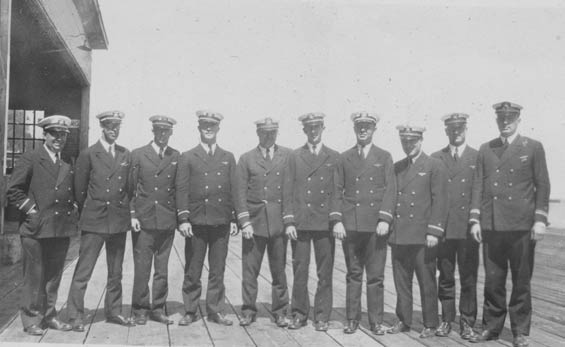 |
Another group of 16 officers is below. I exhibit this photo vertically for easier identification. Compare with the photograph of Homer Wick's page. In the front row from the left, Unknown, George T. Mundorff, Jr., Unknown, Lt. Cdr. Homer Wick, Lieutenant Leslie E. Gehres, Lieutenant Jackson R. Tate and Lieutenant (Junior Grade) Clarence Wade McClusky, Jr.
Group Photograph of Sixteen Officers, Ca. 1928-30 (Source: Barnes)
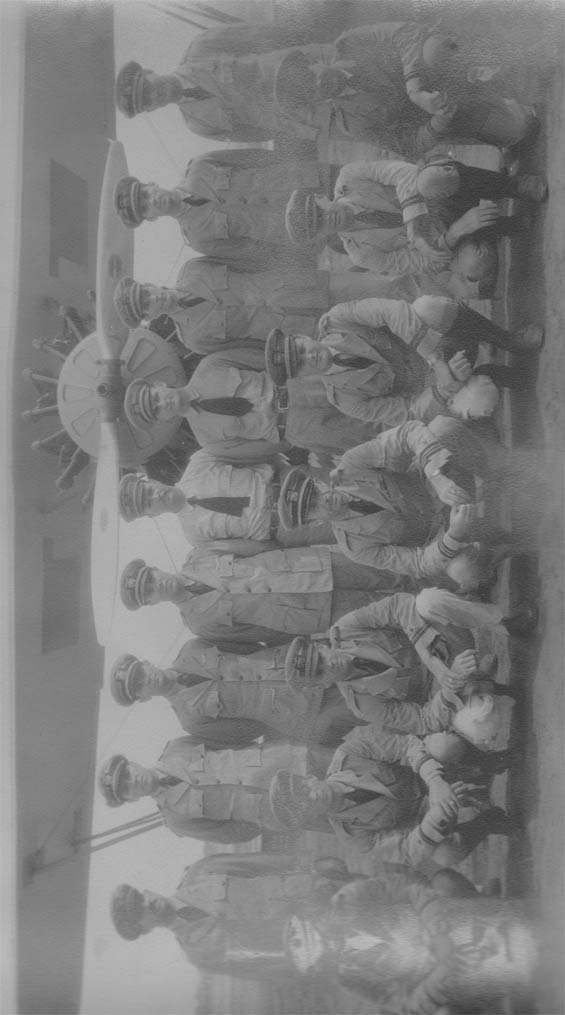 |
In the back row from left are, Unknown, Unknown, Unknown, Unknown, Unknown, Unknown, Lieutenant (Junior Grade) Frederick N. Kivette, Lieutenant (Junior Grade) Frank O'Beirne and Ensign William H. McMullen, USNR. All of these officers landed with McMullen at Tucson April 19, 1929.
Below, McMullen is second from right standing on the ground with three unidentified officers with moustaches. The one on the right appears to be watching airplanes. His trousers are also soiled with oil stains, a common occurence working near radial engines.
McMullen, Second From Right, and Three Unidentified Officers, Ca. 1928-30 (Source: Barnes)
 |
Below are three photographs of rifle practice. The first first two show McMullen seated. In the first, note the person firing from a prone position behind him, and note carefully the person seated next to the shed off McMullen's right shoulder. A betting person would put money on "Harry" being his name, see below.
McMullen Firing a Rifle From a Seated Position, Ca. 1928-30 (Source: Barnes)
 |
Same position, opposite direction.
McMullen Firing a Rifle From a Seated Position, Ca. 1928-30 (Source: Barnes)
 |
Below, a photograph inscribed, "Harry on rifle range." It could be Harry Sartoris (see photograph fourth below).
If this photograph was taken today, Harry would have a cell phone to his ear, but this phone is the old fashioned kind (note the wire held in his right hand). He was probably relaying accuracy information from the target pit back to the shooters. He seems to be enjoying his job on this sunny day.
Harry on Rifle Range, Ca. 1928-30 (Source: Barnes)
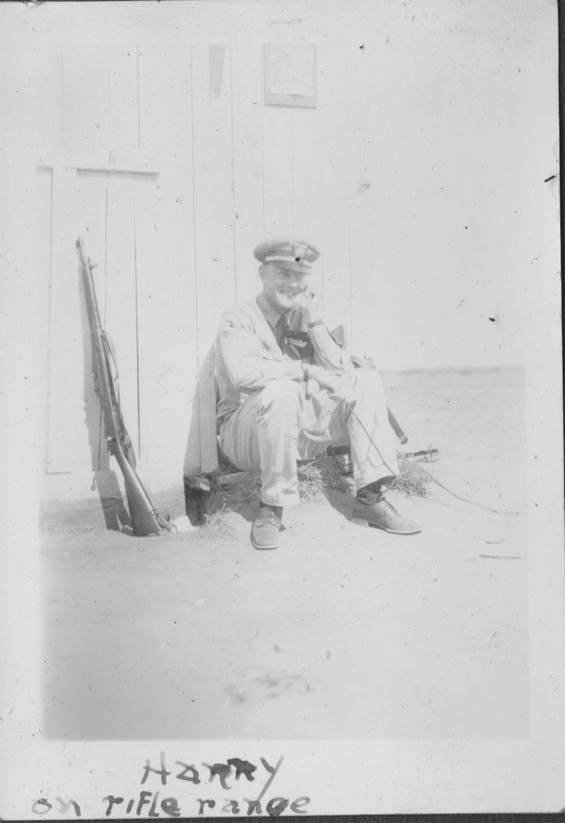 |
Below, McMullen is second from left with Charlie Dolson to his immediate right. Harry stands at far right with his last name illegible. The fourth is Tom Van Stone.
McMullen and Others, Ca. 1928-30 (Source: Barnes)
 |
News of Van Stone, and his death just a few years later as a Vultee test pilot, is below from the Seattle (WA) Sunday Times of September 29, 1935.
Seattle Sunday Times, September 29, 1925 (Source: Woodling)
 |
’25---THOMAS CARROLL VAN STONE.
Died at Glendale, Cal., September 18, 1935. He was chief of stress analysis and chief test pilot for the Aircraft Development Corporation of Glendale, and was killed while making a test flight in a new bombing plane. After his graduation from College, he took the student engineering course at the Philadelphia works of the Westinghouse Electric & Manufacturing Co. [see Register pilot George Westinghouse], and was subsequently made assistant engineer in the mechanical stoker division of the company. He took up aviation and trained at Hampton Roads Naval Base, and received a commission in the U.S. Naval Reserve Air Service. After a year’s active duty with the Pacific fleet, attached to a fighting squadron on the U.S.S. airplane carrier “Saratoga,” stationed in San Diego, he became a design engineer with the E.M. Smith Airplane Manufacturing Co., in Los Angeles, and he remained with that organization until 1933, when he joined the concern with which he was associated at the time of his death. He had retained his commission in the Naval Reserve, and had recently spent two weeks as flight commander of the unit at San Pedro, Cal. He was born at Denver, Col., October 2, 1903, the son of George H. and Mary R. (Hunt) Van Stone, and prepared at the Santa Fe, N.M., High School.
|
In image 2 in the article above, we see fellow Register pilot Jerry Vultee with Van Stone in one of the small fighter-bombers cited in the article. Van Stone was born in Santa Fe, NM in 1903 and graduated with honors from Harvard in 1925 with a degree in engineering. He later became associated with Gerard Vultee at Emsco Aircraft.
He and Vultee later worked together on the V-11 attack aircraft. Van Stone was the pilot on the first flight of the aircraft in 1935. Unfortunately, on the second flight he crashed, killing himself and his copilot. A better photograph of the V-11 is at the link, courtesy of the San Diego Aerospace Museum (SDAM). It probably shows Van Stone in the cockpit.
At right, from an undated Harvard Alumni Bulletin, is Van Stone's obituary. He was a graduate of the class of 1925.
Below, a photo of Tom Van Stone on shipboard.
Tom Van Stone, Ca. 1928-30 (Source: Barnes)
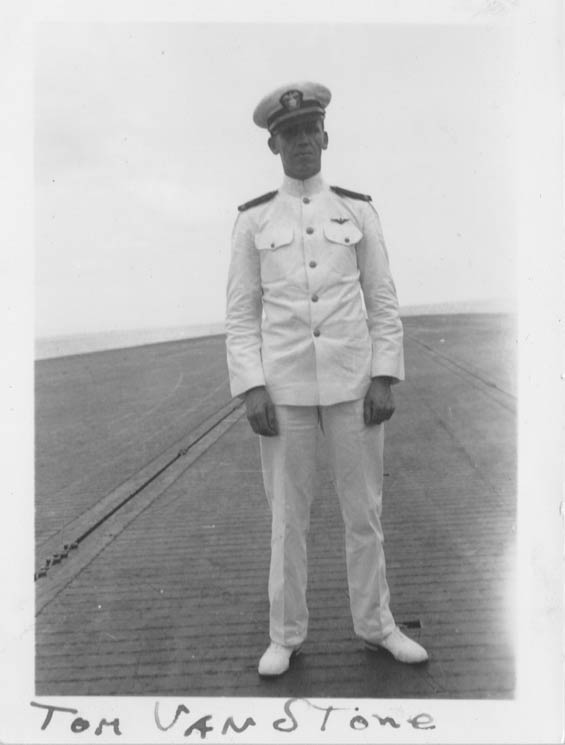 |
Below, a Vought UO-1 with Harry Sartoris (L) and Charlie Dolson, reservists in McMullen's squadron. The aircraft, A-7005 (not a Register airplane), was later converted to a UO-2.
Harry Sartoris and Charlie Dolson, Vought UO-1, August 30, 1928 (Source: Barnes)
 |
Below, an image of the caption for the photo above.
Harry Sartoris and Charlie Dolson, Vought UO-1, August 30, 1928, Caption (Source: Barnes)
 |
Emerson Austen, Date Unknown (Source: Woodling)
.jpg) |
On the caption, we learn that "Em. Austen" stands in shadow by the engine. The film development and printing date was August 30, 1928. We don't know when the photograph was actually taken.
Page contributor Woodling (cited, right sidebar) states, "The 'Em. Austen' shown in the Vought UO-1 photo is likely Emerson Archibald Austen, a USNR carrier pilot and later a pilot for American Airlines." At left is a photograph of Austen from the American Airlines retirees scrapbook. He further states, "... he was #103 on the AAL seniority list, seniority date 5/3/33."
Charles H. Dolson, 86, Chairman of Delta Air
Published: September 6, 1992
Charles H. Dolson, a former chairman of Delta Air Lines, died on Friday at the Georgia Baptist Medical Center in Atlanta, his hometown. He was 86 years old.
The A.C. Hemperley and Sons funeral home in East Point, an Atlanta suburb, said he died of Parkinson's disease and other illnesses.
Mr. Dolson flew for Delta for 13 years, 7 as chief pilot, before joining management in 1947 and becoming vice president for operations. He rose to president in 1965, added the title of chief executive in 1966 and became chairman and chief executive in January 1970.
After he retired as chairman in November 1971, he continued as chairman of the finance committee until 1986. |
And further, "I'm guessing that the 'Charlie Dolson' shown in the Vought UO-1 photo is Charles H. Dolson, later president of Delta Air Lines. Here's a quote from his obit: 'Before joining Delta, he was a carrier pilot in the Navy; a test pilot for Curtiss-Wright Co.; and a pilot for American Airways, later renamed American Airlines.'" Indeed, Mr. Dolson was as described. His daughter contacted me on May 12, 2014 to confirm his identity in the photographs. She says, "Dad retired as Chairman of the Board, CEO, and President of Delta Airlines." He passed away in 1992 and his obituary appeared in The New York Times at right.
Thus, two of the people in the photograph above flew for the early American Airlines company. This is not surprising, since the pool of trained pilots was relatively small in the late 1920s.
Below, another view of A-7005. The officer on the bicycle holds his cigarette in his mouth at a rakish angle.
Vought A-7005 With Unidentified People, 1928-30 (Source: Barnes)
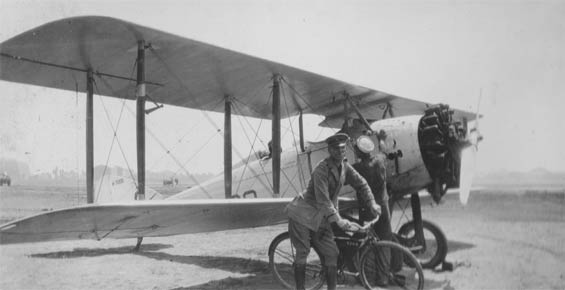 |
Among McMullen's photographs are several of flying boats. Below, what looks like a Curtiss F-5L, location unknown. The airplane has the tail and rudder modification made on all models after WWI. The rudder is kicked to the right and you can only see the top of it as a small triangle pointing out of the plane of the photo.
Curtiss F-5L, Ca. 1928-30 (Source: Barnes)
 |
Another view of the same airplanewith a better view of the modified empennage. The rudder is now kicked to the left.
Curtiss F-5L, Ca. 1928-30 (Source: Barnes)
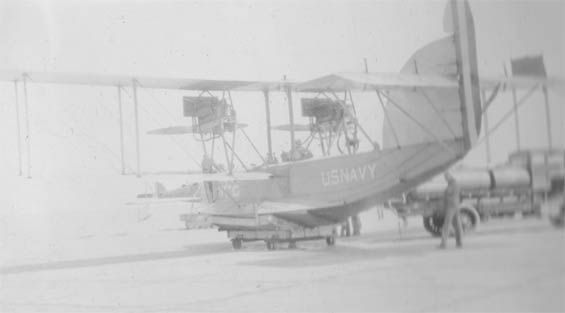 |
Below is the same photograph that I have darkened to show the identification on the fuselage (HR-2 visible forward).
Curtiss F-5L, Ca. 1928-30 (Source: Barnes)
 |
This REFERENCE discusses F-5Ls on pages 114-116. The F-5L was the standard Navy twin-engine patrol boat until the late 1920s.
Below, two photographs of Loening aircraft. The first is an OL-6.
Loening OL-6, Ca. 1928-30 (Source: Barnes)
 |
Below, a Loening OL-8A. The locations of both these two photographs are unknown.
Loening OL-8A, Ca. 1928-30 (Source: Barnes)
 |
Below, a rare photograph of the U.S.S. Shenandoah tethered to its tender ship the U.S.S. Patoka. The Patoka was an oiler that was specially modified with a mooring mast to accomodate the Shenandoah. For size comparison, the top of the mast is 125 feet above the surface of the water. The Shenandoah was wrecked in Ohio on September 3, 1925.
Airship U.S.S. Shenandoah and Tender, U.S.S. Patoka, Before September, 1925 (Source: Barnes)
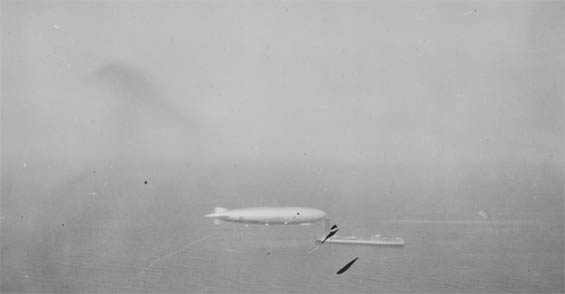 |
Below, a photograph of a dirigible hangar, location unknown. A couple of rows of unidentified biplanes stand in front of the hangar. A plume of smoke drifts to the left.
Dirigible Hangar, Location Unknown, Ca. 1928-30 (Source: Barnes)
 |
BACK TO TOP
---o0o---
---o0o--- ---o0o---
PHOTOGRAPHS OF SHIPBOARD OPERATIONS -- Eighty-four views. Especially interesting and instructive are the photographs of airplanes crowded on carrier decks and of the early arresting gear mechanisms for capturing and stopping aircraft after landing on a carrier deck. Images show activities on-board an aircraft carrier, either the U.S.S. Lexington or the U.S.S. Saratoga.
Immediately below, the bow wave of a carrier underway. If this photo was taken by McMullen during his Panama cruise, it is the Saratoga's bow wave.
Bow Wave, U.S.S. Saratoga (?), Ca. 1928-30 (Source: Barnes)
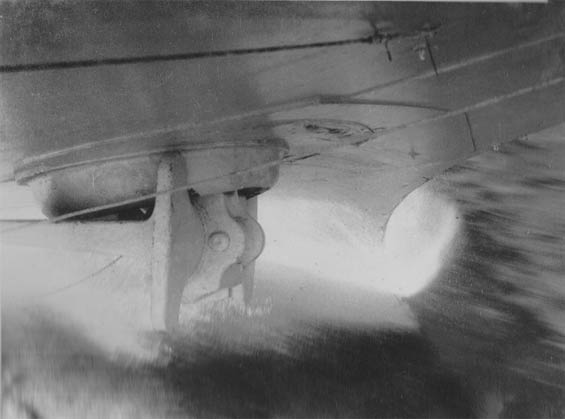 |
Below, the U.S.S. Lexington seen through signal flags, probably from the deck of the U.S.S. Saratoga. This photograph shows elements of aesthetic appreciation uncommon in snapshots.
U.S.S. Lexington Ca. 1928-30 (Source: Barnes)
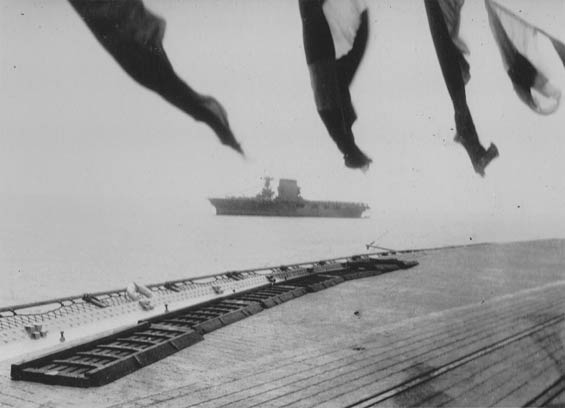 |
Next, a long shot of the U.S.S. Lexington. Note the davit for hoisting aircraft and supplies.
U.S.S. Lexington Ca. 1928-30 (Source: Barnes)
 |
Another view of the Lexington in a little bit better focus showing other ships of the fleet.
U.S.S. Lexington Ca. 1928-30 (Source: Barnes)
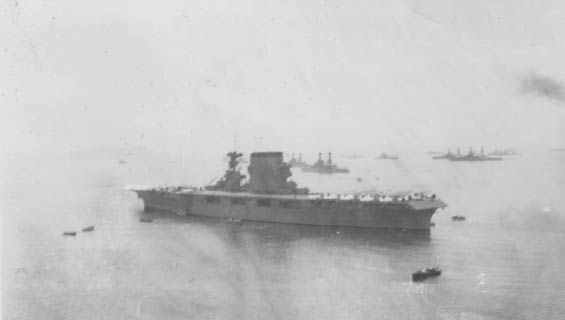 |
Below, several photographs of aircraft on carrier decks. The first is a view of aircraft massed on the deck. Notice that some of the aircraft have their wings folded back. Exact date and location unknown, but it might be on McMullen's way to Panama.
Aircraft Massed on the U.S.S. Saratoga (?), Ca. 1928-30 (Source: Barnes)
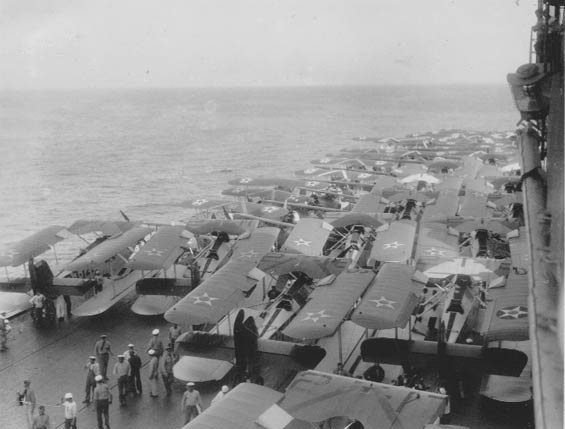 |
Another view of folded wings, with McMullent's remark, "Note how closely they are packed." They are Martin T4M-1 torpedo planes. The T4M-1 was the successor to
the T3M, after the Navy decided to have only aircraft powered by air cooled engines. It was a very large aircraft, with a crew of 3. You can see the large gap between the pilot's cockpit and the rear gunner's position. It was the Navy's standard torpedo plane until the late 1930s monoplane era.
Aircraft Massed on the U.S.S. Saratoga (?), Ca. 1928-30 (Source: Barnes)
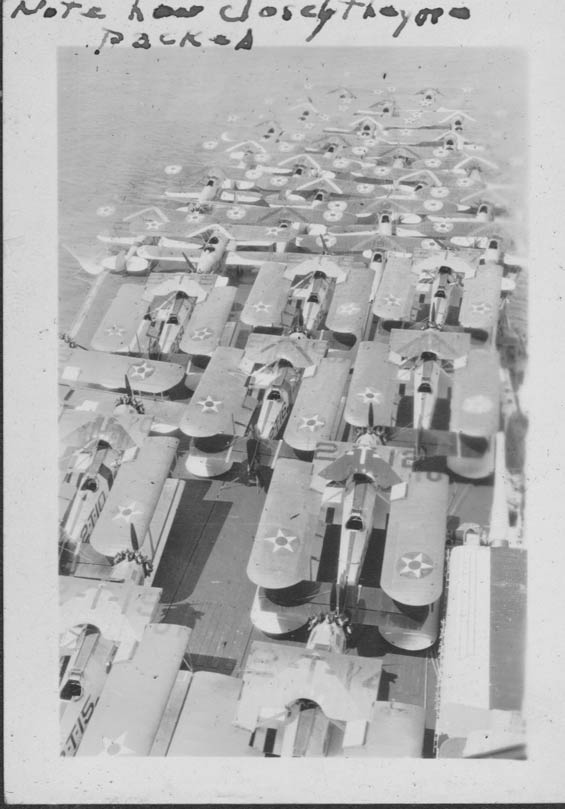 |
Below, detail of a Martin T4M-1 with wings folded. McMullen annotates this photograph, "Wings folded, only takes a few seconds to fold and reassemble wings." Engine cowlings and cockpits are covered with canvas and a rudder lock is in place. The tail of this airplane is supported on a wooden stand, as is the one next to it.
Martin T4M-1, Wings Folded on Carrier Deck, Ca. 1928-30 (Source: Barnes)
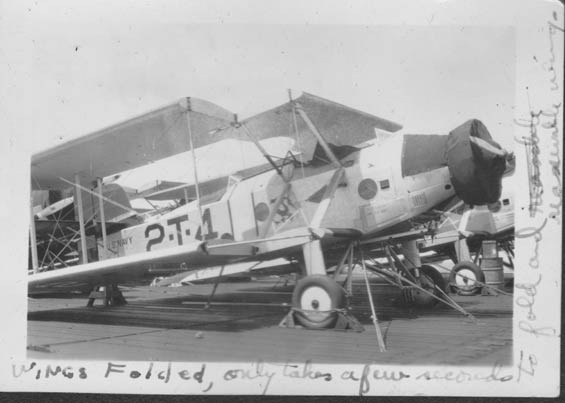 |
Next, four views of Boeings on carrier deck viewed from the "Fighting Tops."
Boeings Massed on Carrier Deck, Ca. 1928-30 (Source: Barnes)
 |
The number of aircraft operating was 85.
Boeings Massed on Carrier Deck, Ca. 1928-30 (Source: Barnes)
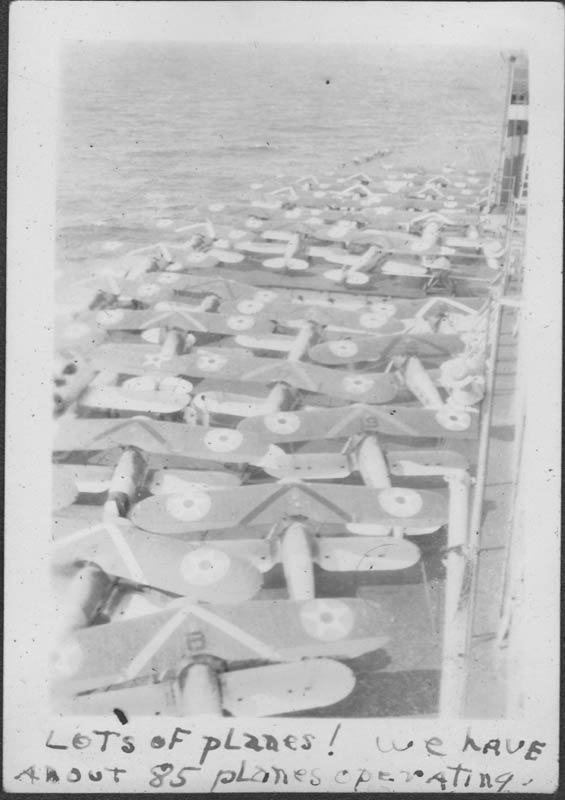 |
Aircraft Massed on Carrier Deck, Ca. 1928-30 (Source: Barnes)
 |
Below, the deck appears to be of the same ship as above (note guns pointing forward and davit, lower right). The aircraft are different.
Aircraft Massed on Carrier Deck, Ca. 1928-30 (Source: Barnes)
 |
Next, what the davit is used for. A Vought observation plane being launched.
Vought Observation Plane on Davit, Ca. 1928-30 (Source: Barnes)
 |
Aircraft Massed on Carrier Deck, Ca. 1928-30 (Source: Barnes)
 |
Aircraft Massed on Carrier Deck, Ca. 1928-30 (Source: Barnes)
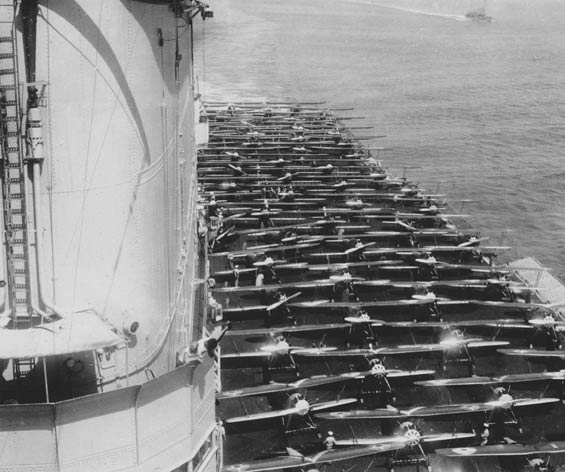 |
Below, another view of the flight deck and aircraft parking area. Note the three men on the midline of the photo standing in a section of the deck with a dark ring around it. Compare this with the next photograph.
Aircraft Massed on the U.S.S. Saratoga (?), Ca. 1928-30 (Source: Barnes)
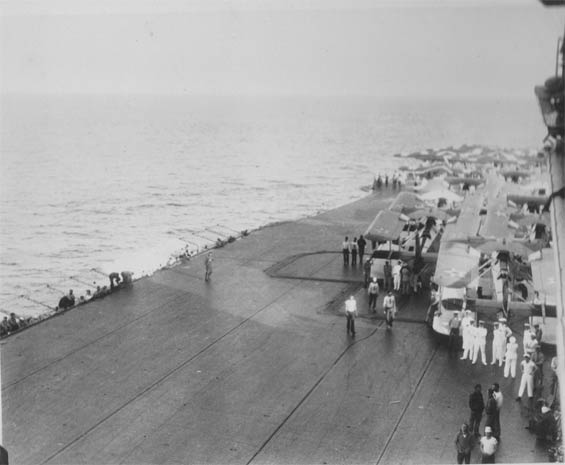 |
Below, a view looking down a deck elevator. The elevator has two Boeing aircraft on it, arranged front to back. It is not clear whether the elevator is moving up or down.
Aircraft on Elevator, U.S.S. Saratoga (?), Ca. 1928-30 (Source: Barnes)
 |
Next, a Vought Corsair on the elevator. It's clear from McMullen's annotation that this Vought Corsair was just lowered. Over a dozen men work to push it backwards off the elevator platform.
Vought Corsair on Elevator, U.S.S. Saratoga (?), Ca. 1928-30 (Source: Barnes)
 |
Below, Vought Corsairs on deck in sunset or sunrise. Like the Lexington framed in signal flags, this photograph has aesthetic sensibility, set at an exposure to capture the foreground detail as well as the blaze of the sun.
Corsairs on Deck; Sunrise or Sunset, Ca. 1928-30 (Source: Barnes)
 |
Below, thtee long views of the carrier deck with aircraft at the far end. McMullen labeled this first one, "Looking Aft." Notice the covers on the engines in this shot. The aircraft appear to be new Boeing F4B-1 or 2s.
Aircraft Deck View, U.S.S. Saratoga (?), Ca. 1928-30 (Source: Barnes)
 |
Next, same ship; different day. A similar view, but the engine covers are off.
Aircraft Deck View, U.S.S. Saratoga (?), Ca. 1928-30 (Source: Barnes)
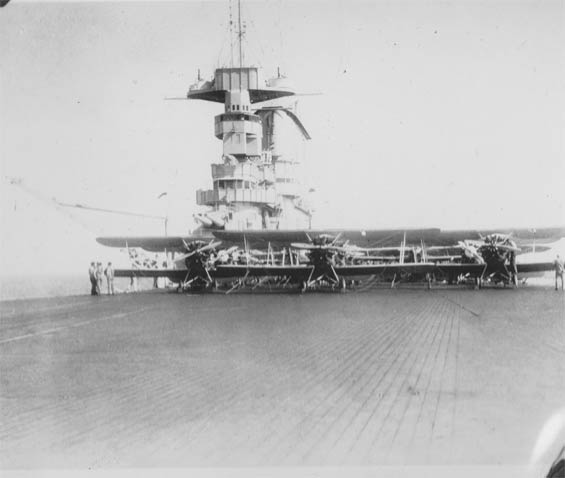 |
The photo above and the next one are different photographs taken at different times. The aircraft are different. Notice the position of the wind sock on the davit. In the photo below, the aircraft are running and probably preparing to depart.
Aircraft Massed on Carrier Deck, Ca. 1928-30 (Source: Barnes)
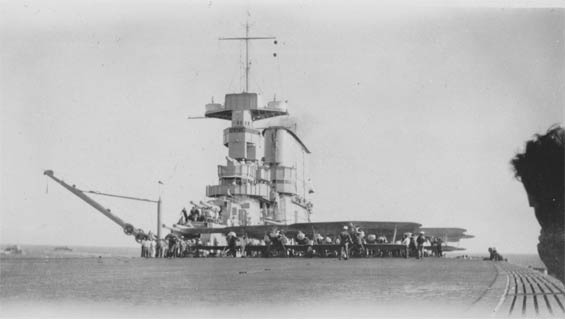 |
Below, an aircraft departing the same carrier (Lexington?). The photographer has now ducked below the level of the deck, into the safety net among shackles and machinery.
Aircraft Departing Carrier Deck, Ca. 1928-30 (Source: Barnes)
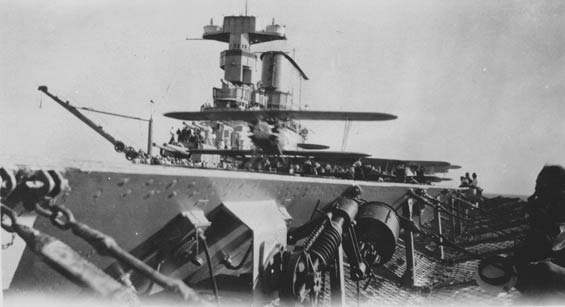 |
Below is a photograph filled with focused expectation. A fleet of airplanes, with engines running, is awaiting their turns to depart. Pilots and deck handlers attend to unseen activities forward. On the fuselage of the central airplane can be seen Felix the Cat carrying a bomb with a burning fuse. This insignia identifies the airplane as a member of Bombing Squadron Two (VB-2B). On the rudder of the forward-most airplane can be read "A-7675" or "A-7679," a Boeing F3B-1. Neither is a Register airplane.
Aircraft Anticipating Departure, U.S.S. Saratoga (?) (Source: Barnes)
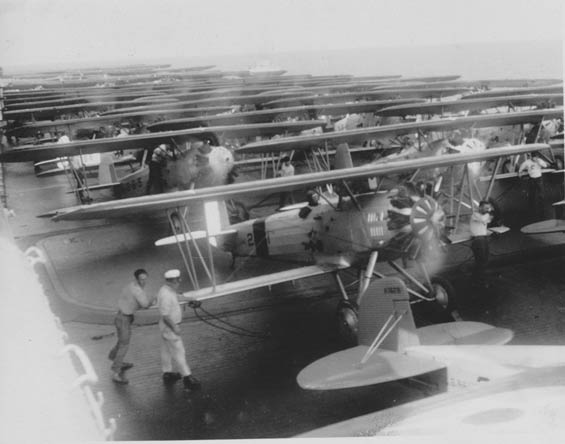 |
Below, a Boeing F2B taking off from a carrier deck. It is unknown if McMullen was in the cockpit.
Aircraft Departing the U.S.S. Saratoga (?) (Source: Barnes)
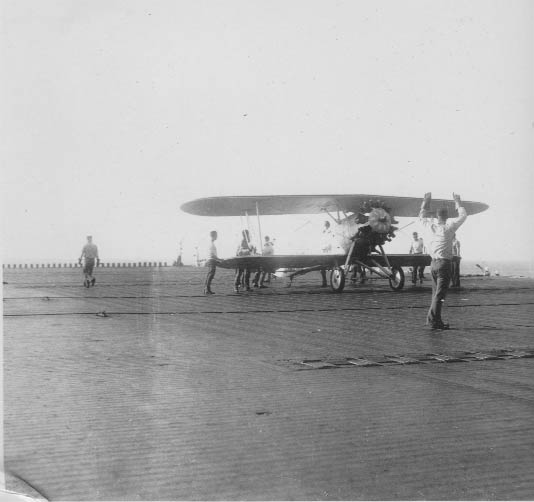 |
Next, McMullen wrote on this photograph, "One of our planes taking off while at anchor in Panama.
Aircraft Takeoff in Panama, Ca. 1928-30 (Source: Barnes)
 |
Below, three more views of aircraft (the first two appear to be Boeing aircraft, which add to the excitment of the photograph by being slightly blurred by speed) departing a carrier deck, perhaps the Saratoga in Panama.
Aircraft Departing the U.S.S. Saratoga (?) (Source: Barnes)
 |
While these two photographs might appear to be closely-timed shots of the same airplane, note the absence of the fuselage stripe in the first airplane. And remember, these photos were probably taken with a camera with a manual film advance. The shots were probably taken sequentially, however. Note the seaman's resting arm on the rail in both views.
Aircraft Departing the U.S.S. Saratoga (?) (Source: Barnes)
 |
Below, a departure viewd from the starboard side of the deck. The airplane is airborne well before the end of the deck. Note the men watching the proceedings while seated in the safety net. They would be at risk in the event of an aborted takeoff with loss of control by the pilot.
Aircraft Departing the U.S.S. Saratoga (?) (Source: Barnes)
 |
Below, a departure by A-8095, the Vought O2U-2 Corsair with which McMullen is posed above. The tail hook is visible at the rear just in front of the tail skid. Just aft of the rudder is a pontoon plane in the distance. This was probably the rescue aircraft patrolling for possible downed pilots. Mountains are in the background, suggesting this is another photo of a departure while the Saratoga was docked at Panama. Given McMullen's presence and kind words with this airplane above, chances are good that McMullen is in the cockpit.
Vought O2U-2 Corsair, A-8095 Departing Carrier Deck, Ca. 1928-30 (Source: Barnes)
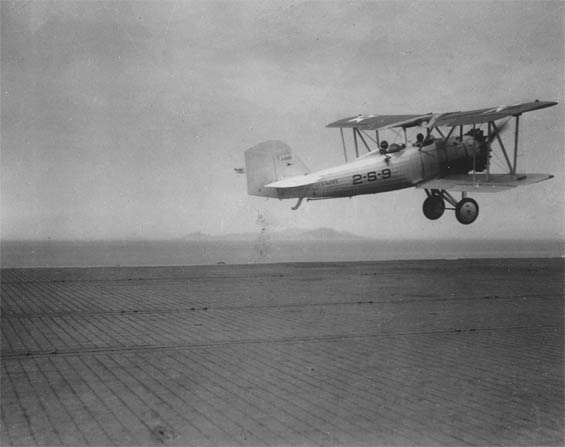 |
Next, tail up, another O2U-2 takeoff. The axle grappling hooks and the tailhook and tail skid are nicely visible in this photograph. The pilot holds the stick slightly to the right making the left wheel slightly more ready to lift off the deck than the right. I pushed this photograph in PhotoShop, but could not resolve the Bureau Number on the vertical stabilizer. This airplane is also seen below at rest on the deck posed with an unidentified officer.
Vought O2U-2 Corsair Departing Carrier Deck, Ca. 1928-30 (Source: Barnes)
 |
Below, a departure by A-7725, a Boeing F3B-1 (not a Register airplane). This is a beautiful action image showing the Felix the Cat insignia on the fuselage, indicating the airplane and pilot are members of Bombing Squadron Two (VB-2B). The arresting gear grapple hooks are visible between the wheels on the main gear axle, and the main tail hook is visible at rear in front of the tail skid. The pilot is attentive, looking out the left side of the cockpit, with his scarf streaming in the wind. He is probably watching the crew member who is head and shoulders above the deck line controlling the action. The tires are decompressed and just about to leave the deck. The rudder is not deflected much, which would be expected of an aircraft departing a ship heading directly into the wind. This photograph was taken at a very high shutter speed; the tire inflation valve port is stopped at top dead center of the near landing wheel, and the propeller, although blurred, did not travel very far in its arc.
Boeing F3B-1, A-7725 Departing Carrier Deck, Ca. 1928-30 (Source: Barnes)
 |
Below, a departure photographed from high in the tower. Note the other departing airplane at the upper right-hand corner.
Aircraft Departing the U.S.S. Saratoga (?) (Source: Barnes)
 |
Below, a view (probably at takeoff) of the relatively rare Vought O2U Corsair modified for amphibious operation. Note the wheels in front of the wing stabilizer pontoon. Notice also the elevator is slightly down to keep the tail up. According to this REFERENCE, page 390, "As well as operating from land or aircraft carriers with a wheel chassis, the Corsair was designed for use from battleships and cruisers as a floatplane with a single central float and wingtip stabilizers. To permit greater interchangeability or role an amphibious float was developed for the O2U-1 in 1928, consisting of wheels each side of the main float which swung up to lie partially submerged in the top of the float when the aircraft was operating as a float plane."
Vought O2U-1 Corsair Departing the U.S.S. Saratoga (?) (Source: Barnes)
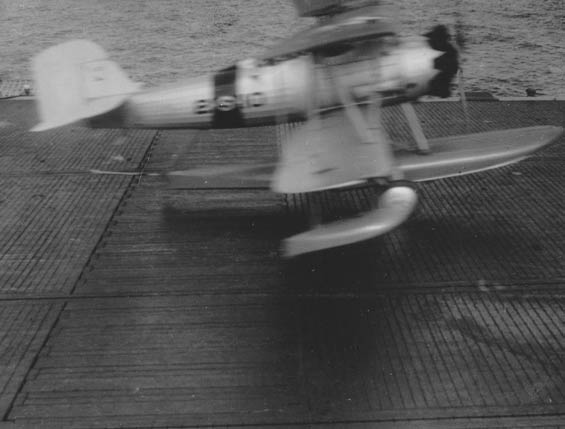 |
The swing-up wheel chassis is clearly visible above and in the next photograph, below. Another view of the chassis is at aerofiles.com, and it shows how the aircraft was handled on the ground via a dolly placed under the rear of the central pontoon. Another profile view of 2-S-10 a couple of dozen images below illustrates that the rear of the pontoon was reinforced with a tail skid to ride directly on the deck during takeoff and landing.
Vought O2U-1 Corsair Departing the U.S.S. Saratoga (?) (Source: Barnes)
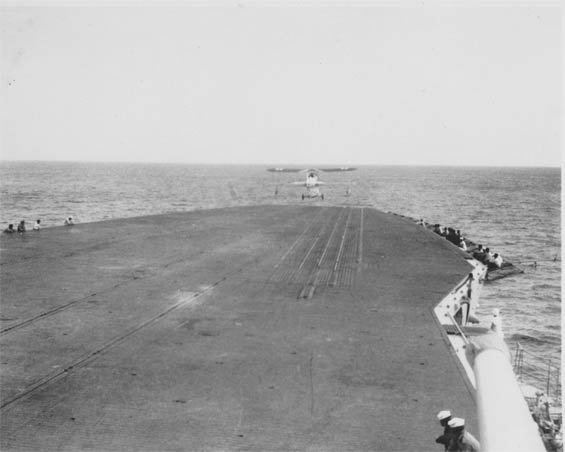 |
Below, two Vought Corsairs in formation. The location is unknown.
Vought Aircraft in Formation, , Ca. 1928-30 (Source: Barnes)
 |
Below are views of aircraft retrieval. On the first one, McMullen wrote, "Just about to settle in to the gear," by which he meant the deck arresting gear, not the airplane's landing gear. The small, rectangular structures elevated above the deck supported the arresting cables.
Aircraft Coming Aboard, Ca. 1928-30 (Source: Barnes)
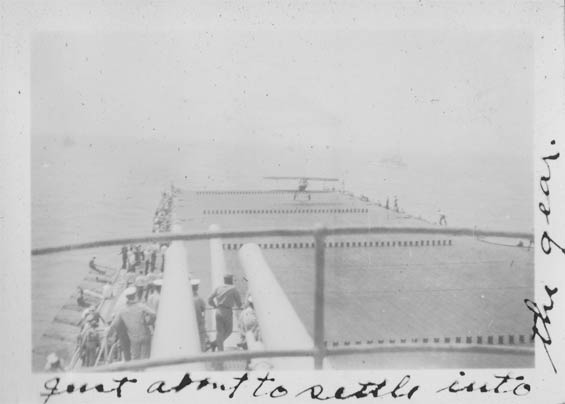 |
Below, another, longer view of a landing. The arresting gear cable devices are seen better in this image.
Aircraft Coming Aboard, Ca. 1928-30 (Source: Barnes)
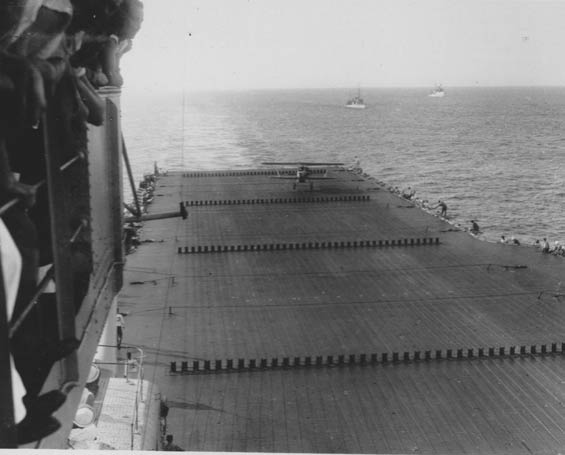 |
Next, a view of arresting gear and two aircraft on final approach to landing. This photograph and the one following were taken from approximately the same position on deck.
Aircraft Coming Aboard, Ca. 1928-30 (Source: Barnes)
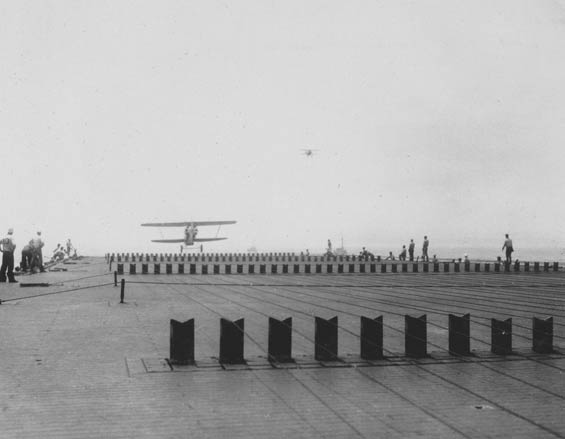 |
Below, another view of arresting gear and two aircraft on final approach to landing. The second aircraft is visible as the blurred dot just above starboard wing of the nearer airplane. The juxtaposition of the aircraft gives a hint of how closely coupled landings were timed. The deck crew had to work quickly to untangle the landed plane and get the gear in shape for the next arrest. The arresting cables and their supports are nicely shown in this view. Notice the deck crew at right and left ready to run in and unfoul the airpane.
Aircraft Coming Aboard, Ca. 1928-30 (Source: Barnes)
 |
In an old, silent film entitled "The Flying Fleet" made in 1929, there are landing sequences aboard the U.S.S. Langley that used the same arresting gear. The operation of the wire supports is shown nicely in a couple of the scenes.
This film is worth watching, as it was made with full cooperation of the Navy and has scenes of Naval Air Station Pensacola and San Diego. As well, in the film two Navy aircraft are identifiable by number. They are the Curtiss F6C-3, A-7144 (modified for racing and later modified as an F6C-6), and the Boeing F2B-1, A-7429. Neither are Register airplanes.
Below, a sister ship waits off the centerline for the aircraft on short final to come aboard.
Aircraft Coming Aboard, Ca. 1928-30 (Source: Barnes)
 |
Below, yet another view of a landing aircraft. This image shows the arresting gear cables arrayed in the optimum manner to catch either the grapple hooks attached to the axle of the landing wheels, or the tail hook. The elevator, shown in a couple of the images farther above, is the square at foreground. Although taken from slightly different positions on the ship, this image and the one just above are remarkably similar, featuring the same model aircraft.
Aircraft Coming Aboard, Ca. 1928-30 (Source: Barnes)
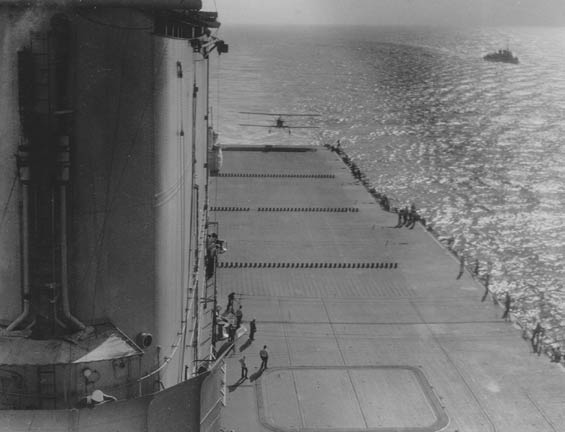 |
Below, a Vought Corsair coming aboard, nose high. Note the tailhook extended straight down.
Corsair Coming Aboard, Ca. 1928-30 (Source: Barnes)
 |
Taken from farther upwind on the deck, this aircraft is a little farther down the deck than the one above.
Aircraft Coming Aboard, Ca. 1928-30 (Source: Barnes)
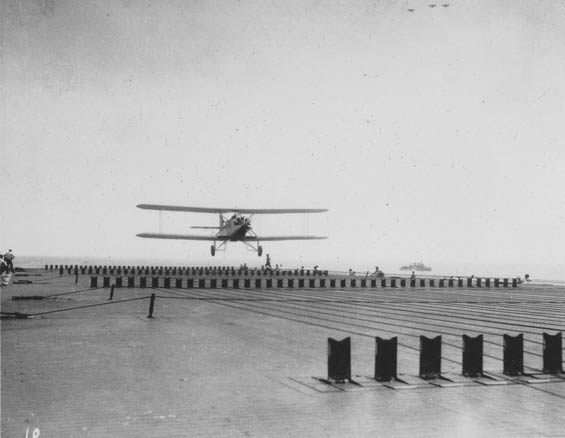 |
On the deck with team rushing to untangle cables.
Post-Landing, Preparing to Free Cables, Ca. 1928-30 (Source: Barnes)
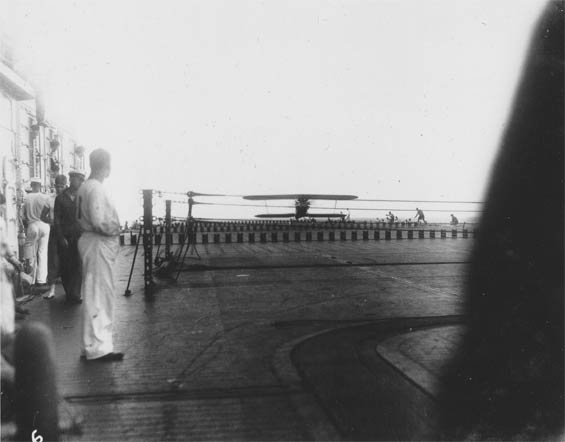 |
After landing, the deck crew freed the cables. Note that the rectangular cable holders are retracted flat against the deck.
Post-Landing, Freeing the Cables, Ca. 1928-30 (Source: Barnes)
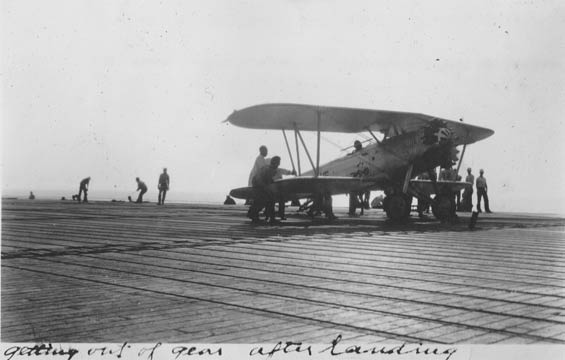 |
Another view of the arresting gear partially retracted and the airplane being guided forward by deck handlers. Note the escort vessels in the background.
Post-Landing, Deck Handling, Ca. 1928-30 (Source: Barnes)
 |
After the cables are freed, deck handlers escort the airplane forward, probably to the elevator for transport below decks. Note, the airplane below is not the same one as the one above.
Post-Landing, Deck Handling, Ca. 1928-30 (Source: Barnes)
 |
Below, a rear view of another landed Martin T4M-1 being escorted forward. Notice that the pilot caught at least the second wire.
Post-Landing, Deck Handling, Ca. 1928-30 (Source: Barnes)
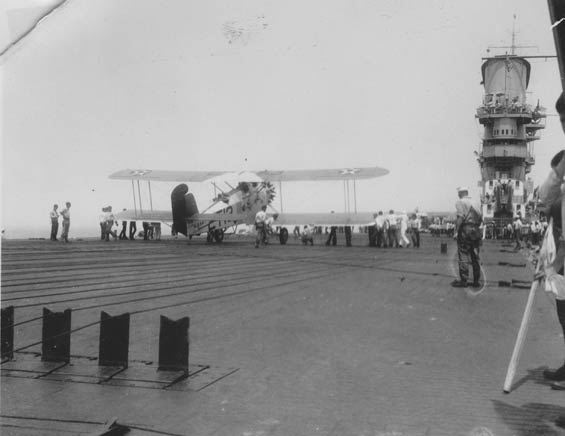 |
Below, an excellent view of the arresting gear looking toward the aft of the ship. Notice the water puddling on the deck. Wear and tear on the lateral surfaces of landing wheels must have been terrific, requiring thorough inspections after each landing.
Arresting Gear, Probably U.S.S. Saratoga, Ca. 1928-30 (Source: Barnes)
 |
Sometimes the cables are missed altogether and airplane and pilot are, "Saved by the net."
"Saved by the net," Ca. 1928-30 (Source: Barnes)
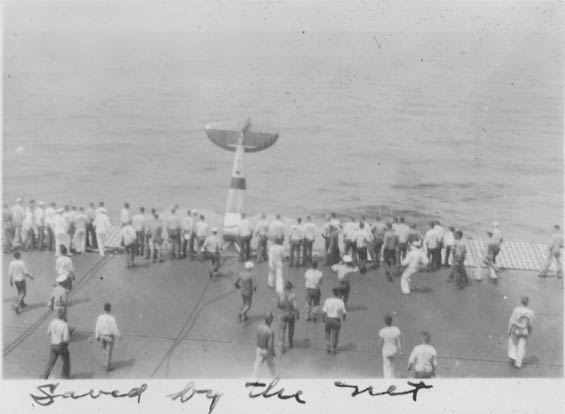 |
Below, another view of what looks like a different airplane over the edge. Notice that the tail has been belayed with a line.
"Saved by the net," Ca. 1928-30 (Source: Barnes)
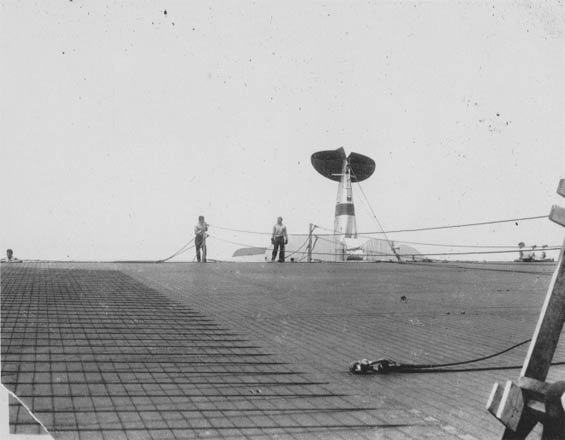 |
Below, another angle of the airplane caught in the net. Notice that there is very little damage to the airplane or propeller and engine, due to the fact that it nosed over between the net support arms. The port wing leading edge has been crushed and penetrated in two places by the net support arms. The net is damaged, probably cut either by the propeller or by crew members in the effort to free the airplane and right it. The challenge to the crew is now to get it back on the deck and upright without doing further damage. The airplane is A-7430 (not a Register airplane). The number is clearly readable on the vertical stabilizer in the original photo. It is a Boeing F2B-1.
"Saved by the net," Ca. 1928-30 (Source: Barnes)
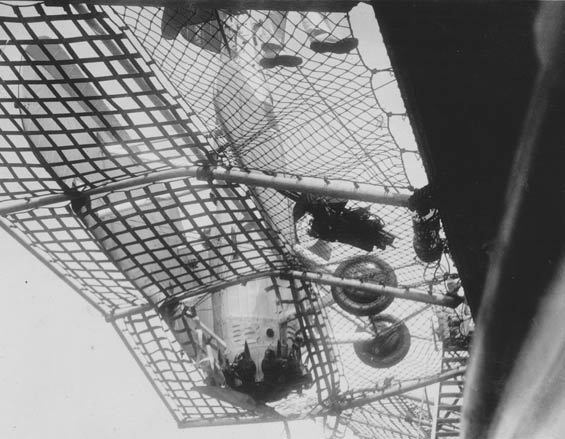 |
Below, another use for the net: pilots doing what they do best after a hard day of aviating. McMullen could justifiably, and with tongue-in-cheek, have labeled this photograph, "Saved by the net."
Pilots At Rest, Ca. 1928-30 (Source: Barnes)
 |
Below, another view of officers in the net. They are unidentified, but the one on the right could be Jack Diffley. Does anyone KNOW who they, or the ones above, are?
Men At Rest, Ca. 1928-30 (Source: Barnes)
 |
Below, McMullen stands between a pair of Vought O2U-2 Corsairs, A-8119 and A-8120 (neither is a Register airplane). A-8119 was assigned to the Coast Guard in 1934. Note the turtle with wings insignia. The winged turtle insignia was painted on aircraft which had crossed the Equator (see below).
W. H. McMullen and Aircraft, Carrier Deck, Ca. 1928-30 (Source: Barnes)
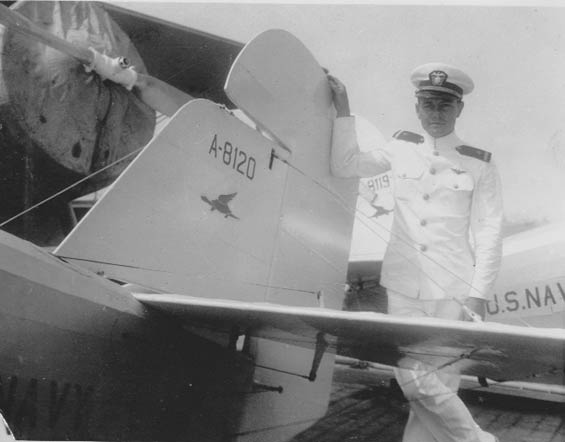 |
Next, an unidentified officer stands by another O2U Corsair, A-8110 (not a Register airplane).
Unidentified Officer and Vought Corsair, A-8110, Carrier Deck, Ca. 1928-30 (Source: Barnes)
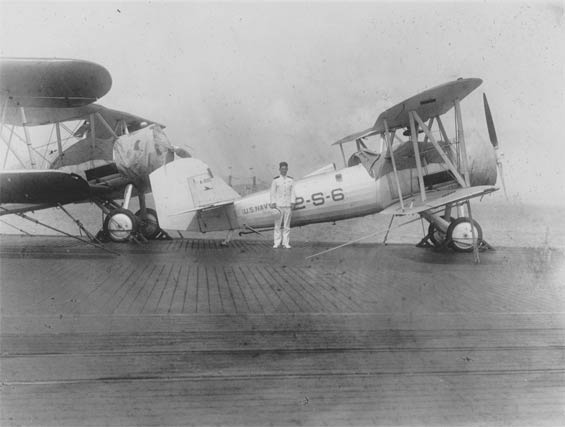 |
Below, another photograph (not sure if the officer is McMullen) taken on shipboard. The airplane is another Corsair, A-8107, (not a Register airplane) on floats. The number of the aircraft in front of 8107 is unreadable on the original.
Vought Corsair A-8107, Carrier Deck, Ca. 1928-30 (Source: Barnes)
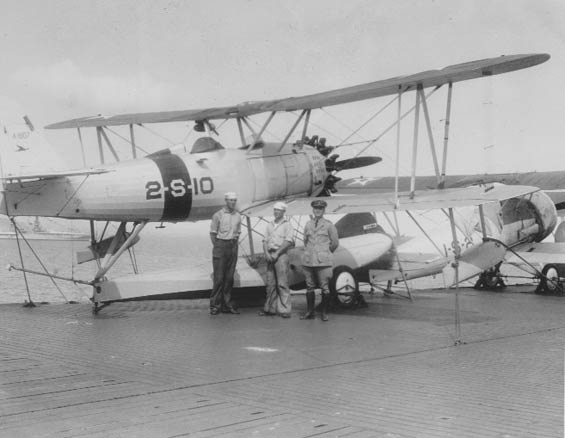 |
Below, McMullen, second from left, poses under big guns with Jack Diffley (L), Jimmy Javes and Larry Clousey. Notice the life vests on McMullen and the other pilot at left.
McMullen, Second From Left, and Three Unidentified Officers, Ca. 1928-30 (Source: Barnes)
 |
Next, McMullen (L) with an unidentified pilot. McMullen wears the same style life vest.
W. H. McMullen (L) and Unidentified Officer, Carrier Deck, Ca. 1928-30 (Source: Barnes)
 |
Below, a group of seven ensign aviators. They are unidentified. They appear to be freshly dressed and just on deck for some kind of ceremony.
Seven Unidentified Ensigns, Ca. 1928-30 (Source: Barnes)
 |
Joe Liston, Purdue Univ., Date Unknown (Source: Purdue via Woodling)
 |
Next, six ensigns of VS2 from what looks like the same photo shoot as above. Notice the aircraft wings protruding over their heads. Along the edge of the original photo, these men are identified as (back row, L-R) Ted Frederick (USNA 1926; Navy records indicate he retired as a captain in 1956, but his obituary cites him as a rear admiral), Kewpie Kimpler (USNR pilot Joseph Henry Kimpler; designated Naval Aviator #4453 in 1926; became captain), Frank Kern (Frank Block Kern, left the Navy and became a Curtiss test pilot and later flew for Eastern Airlines, rising to the position of Chief Pilot); (middle row, L-R) W.M. McMullen, Joe Liston, with Jack Diffley in front. Liston later (1937) became a professor of aeronautical engineering at Purdue University. Liston's primary interest was in aircraft propulsion (his nickname was "Piston Joe"), and he developed several outstanding power plant design courses and test facilities during the 1940's. He remained on the Purdue staff until retiring in 1972. He died August 7, 1978. Photo, right, of Liston during his Purdue tenure, date unknown. Other photographs of Liston at Purdue are at the link.
Six Ensigns, Ca. 1928-30 (Source: Barnes)
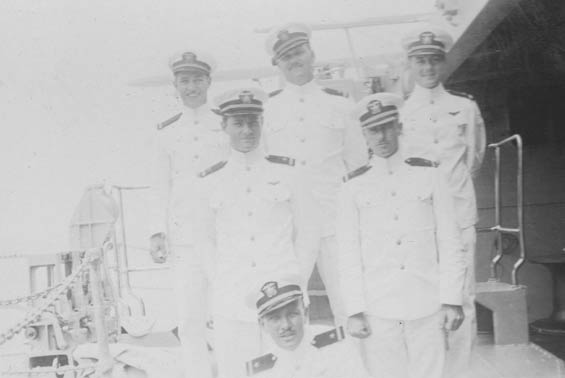 |
Another view of the six ensigns of VS2.
Six Ensigns, Ca. 1928-30 (Source: Barnes)
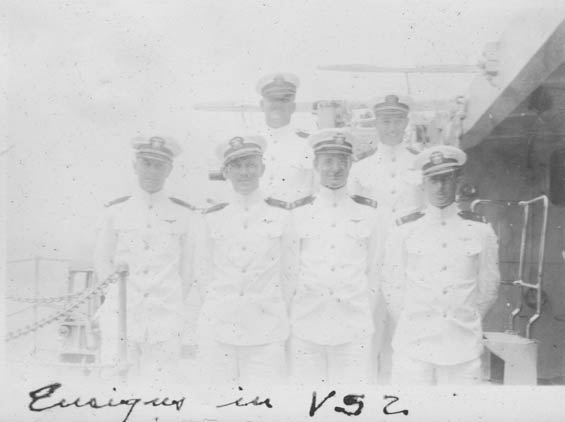 |
Below, a photograph of Kewpie Kimpler standing alone in front of a Boeing with VS2 high hat insignia.
Kewpie Kimpler, Ca. 1928-30 (Source: Barnes)
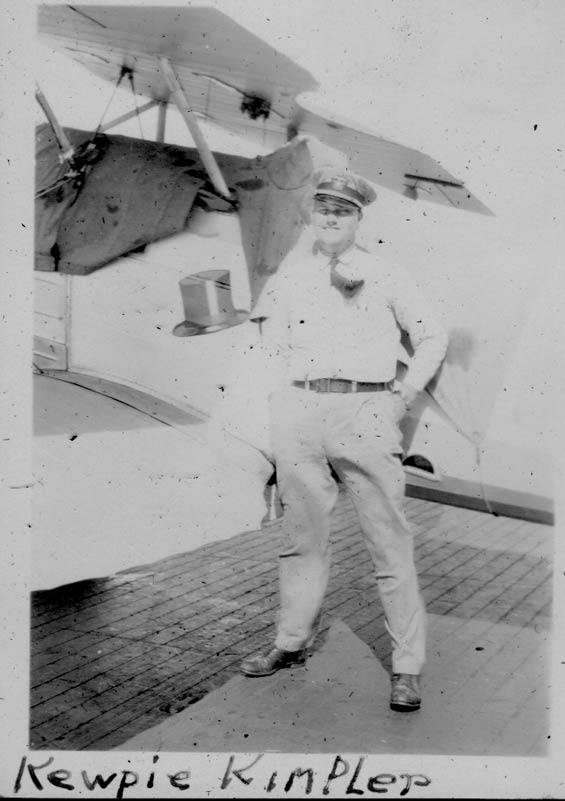 |
Next, an unidentified photograph of officers followed by three ensigns of VB2, followed by three identified officers.
Three Ensigns of VB2, Ca. 1928-30 (Source: Barnes)
 |
They are identified as Tom VanStone, Charlie Dolson and Harry Sartoris (see other photos above). Below, another view of VanStone and Sartoris.
Harry Sartoris (L) & Tom VanStone, Ca. 1928-30 (Source: Barnes)
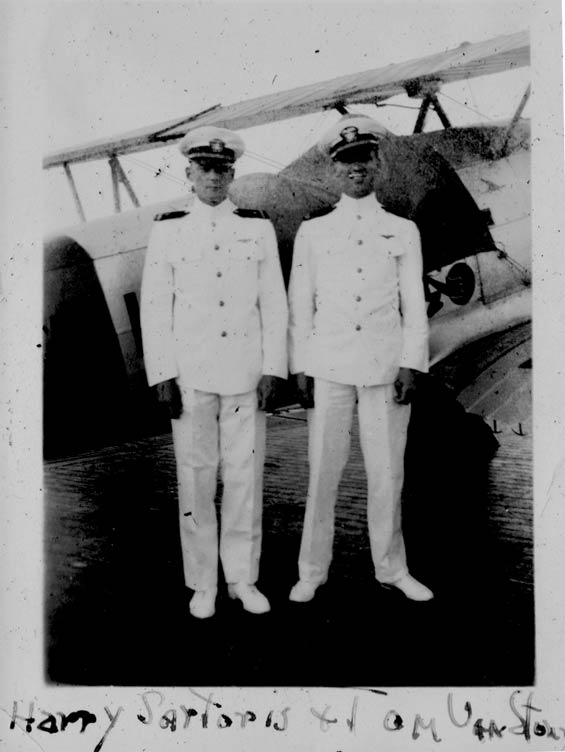 |
Below, two additional unidentified officers in dress whites. This photograph was over-exposed. Does anyone KNOW who they are?
Two Unidentified Officers, Ca. 1928-30 (Source: Barnes)
 |
Below, three views of the ceremony of "Crossing the Line," celebrating sailors' first crossings of the Equator. McMullen is not identifiable among those present. Since the Equator is about 650 statute miles south of the Panama Canal, this crossing and ceremony might have been part of McMullen's cruise, serving as a morale booster for the men. The history and lore of the ceremony is just a Google search away.
"Crossing the Line" Ca. 1928-30 (Source: Barnes)
 |
Below, King Neptune holds his trident while flanked by two sailors in drag, one of them representing her Highness Amphitrite. Sailors who withstand the ceremony are forever after known as "Trusty Shellbacks" or "Sons of Neptune."
"Crossing the Line" Ca. 1928-30 (Source: Barnes)
 |
Below, a wide view of the ship's company assembled for the ceremony. There is a gaunlet diagonally left to right in the photo, with two sailors "running the gauntlet," bent over to avoid blows and other insults. Upon close examination, some of the sailors forming the gauntlet can be seen holding clubs and whips. "Crossing the Line" could be a painful and bloody affair, and some sailors are known to have lost their lives in the early days (18th & 19th centuries) of the custom.
"Crossing the Line" Ca. 1928-30 (Source: Barnes)
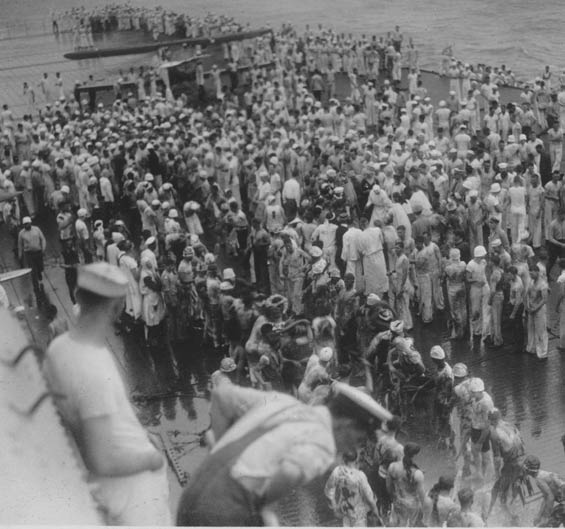 |
"Crossing the Line" as a brutal ceremony was abandoned in the 20th century, and while it is still practiced, it is a much milder affair in the 21st.
Below, "Deck tennis at anchor in Panama."
"Deck Tennis at Anchor in Panama," Ca. 1928-30 (Source: Barnes)
 |
Below, a panorama photograph of a fleet at anchor, location and date unknown, but probably Panama early in 1930. There are no aircraft carriers visibile among the widely dispersed ships. I have posted this photograph vertically so you can see the detail. It was taken in several shots by McMullen. I stitched his photographs together with PhotoShop.
Fleet at Anchor, Date & Location Unknown (Source: Barnes)
 |
Below, an unidentified ship at dockside. The ship is probably the battleship (BB35) U.S.S. Texas. At the link, you'll notice the date of the photo at the bottom of the page is 1929, which agrees with the date of McMullen's visit to Panama.
Unidentified Ship at Dockside, Ca. 1928-30 (Source: Barnes)
 |
Next, another of the "battle wagons." It's not the same ship as above, rather it is one of the three New Mexico class battleships (New Mexico, Idaho or Mississippi).
"One of the Battlewagons," Ca. 1928-30 (Source: Barnes)
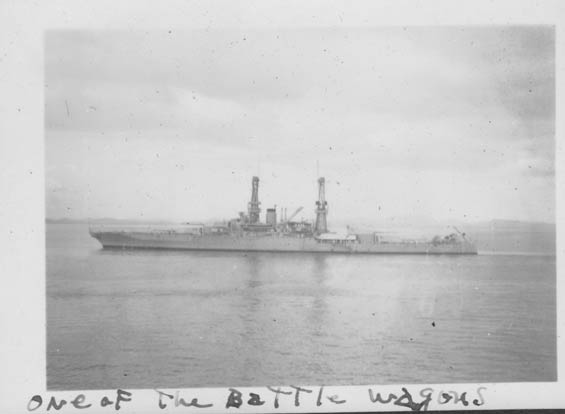 |
Below, an aerial photograph in formation with what looks like a Curtiss CS. A fabric "Slip Meter" is on the outboard strut. Note the interesting junction hardware for the single and double wire braces.
Flying Formation With a Curtiss C-7 (Source: Barnes)
 |
Below, an aerial view of what appears to be a smokescreen laid across the path of McMullen's aircraft. It is not clear if the smoke was laid by a ship or aircraft. There appears to be a shoreline in the distance, with the smoke lying a mile or so off shore, roughly parallel to the coast. A smokescreen also uniquely features in the biography of Register pilot Roland Birnn.
Smokescreen, Aerial View, Ca. 1928-30 (Source: Barnes)
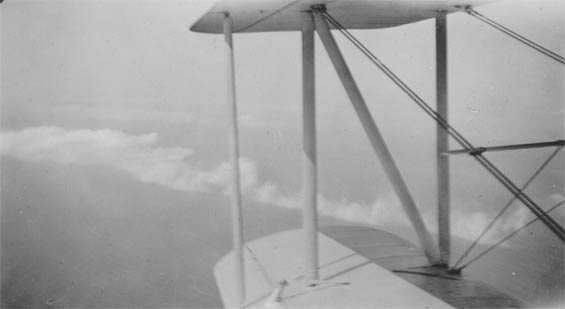 |
The next grouping of photographs were taken almost exclusively on shipboard. Below, two views of unidentified sailors.
Unidentified Seamen, Ca. 1928-30 (Source: Barnes)
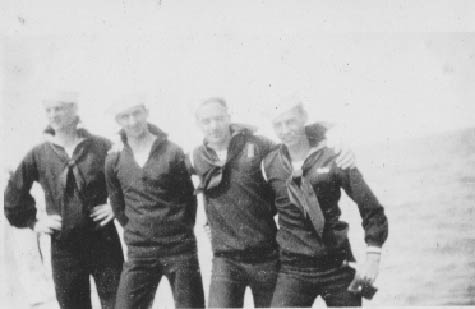 |
Unidentified Seamen, Ca. 1928-30 (Source: Barnes)
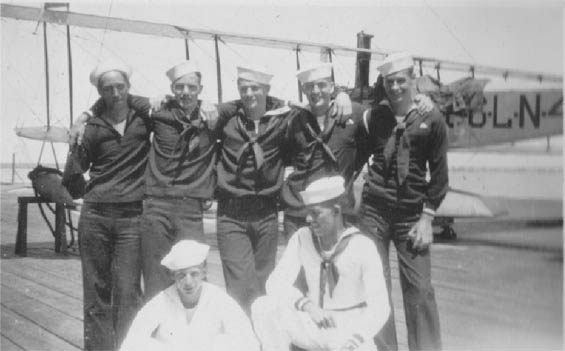 |
Below are three unidentified officers standing in front of aircraft. The officer at center looks a lot like William V. Davis, Jr., who, as navigator for Register pilot Art Goebel, flew the Travel Air Woolaroc across the Pacific to win the Dole Race in August, 1927. Davis was at one time the Landing Signal Officer aboard the Saratoga.
Three Unidentified Officers, Ca. 1928-30 (Source: Barnes)
 |
Unidentified Officers on Deck, Ca. 1928-30 (Source: Barnes)
 |
Below, two unidentified officers. Does anyone KNOW who they, or the ones above, are?
Two Unidentified Officers, Ca. 1928-30 (Source: Barnes)
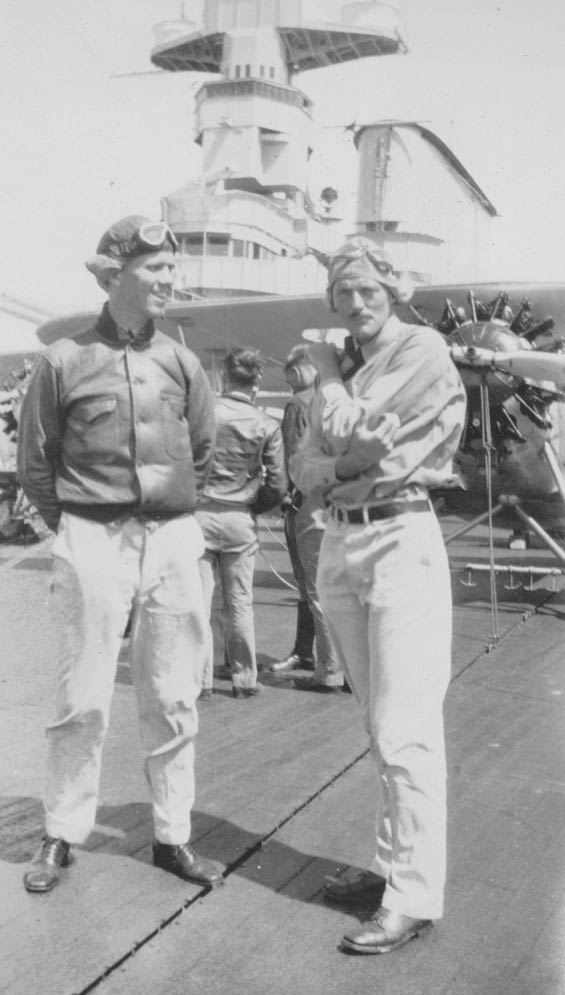 |
Below, McMullen is on the right, with an unknown pilot in flight jacket and helmet. Why the earlobe tweak is a mystery. Notice the camera carried by the officer on the left. It appears to be a bellows type, 120 roll film format. Please direct your browser to the link to see your Webmaster holding a similar camera.
McMullen, Right, With an Unidentified Officer, Ca. 1928-30 (Source: Barnes)
 |
Another unidentified officer posed in what might be a deck tug.
Unidentified Officer in Tug, Ca. 1928-30 (Source: Barnes)
 |
Below, another mustachioed aviator, unidentified.
Unidentified Officer, Ca. 1928-30 (Source: Barnes)
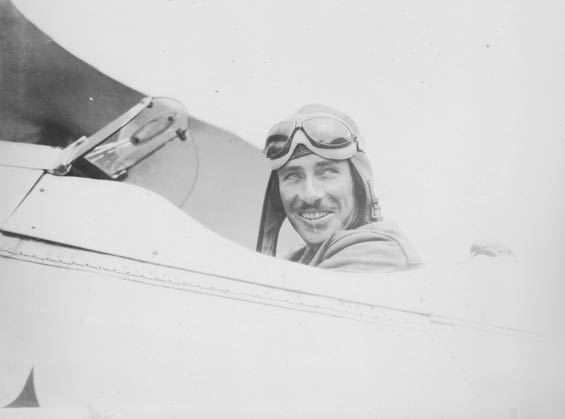 |
BACK TO TOP
---o0o---
---o0o--- ---o0o---
CIVILIAN PHOTOGRAPHS -- Thirty-five views. These photographs show people in civilian activities mostly related to sightseeing. Most are unidentified. If you can help with the identification, please let me KNOW.
Below, McMullen had two siblings. Left to right, McMullen, sister Mary and brother Wesley.
William H., Mary and Wesley McMullen, Ca. 1928-30 (Source: Barnes)
 |
Below, an artist's color rendition of the U.S.S. Saratoga with an aircraft departing the deck.
U.S.S. Saratoga Print, 1929 (Source: Barnes)
 |
Contributor Barnes states about this print, "This picture and its inscription were in my aunt's belongings. In other words, her husband, Wesley McMullen, kept this picture in his personal items until the end. Wesley McMullen died in 1983 or 53 years after his brother's death." The inscription on the back of the print is below.
U.S.S. Saratoga Print, 1929, Caption (Source: Barnes)
 |
An interesting finding is that almost the exact picture is found as the frontispiece in the 1928 volume of the Aircraft Year Book. Below, we find the artist was Walter L. Greene. Note the differences between the color image and the frontispiece. There are several that are clear and some not so clear. Please note that this image was not in McMullen's albums.
U.S.S. Saratoga Frontispiece, Aircraft Yearbook, 1928 (Source: Webmaster)
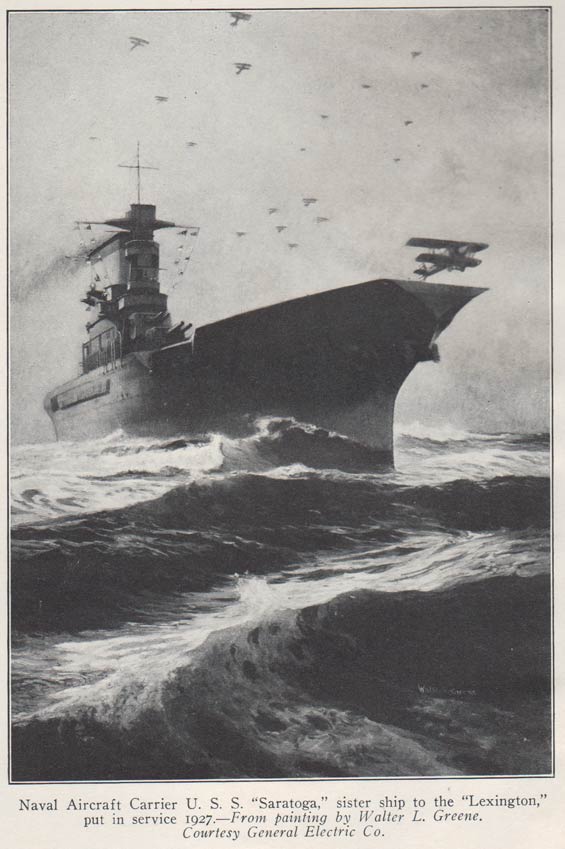 |
To continue, below, a man sits on the bow of what looks like a motorboat. But notice the wings. It is actually an airplane.
Man Sitting on Bow of Unidentified Craft, Ca. 1928-30 (Source: Barnes)
 |
Site visitor Bob Woodling indenifies the aircraft, "It is most likely a Boeing B-1E Flying Boat (ATC #64). Two of the B-1Es were registered as NC115E and NC116E. Another variant is a possibilty: the Boeing Model 204 (ATC#157), registered NC874E, NC875E, NC876E. There was also a Canadian-produced version, four of which were built as Model C-204 Thunderbirds (registered as CF-ALA/CF-ALD). Juptner says that one of the planes was used for sightseeing around Catalina Island." Further, he discovered that, "Western Air Express acquired Pacific Marine Airways in May 1929. The acquisition included a Boeing Model 204, registered NC874E. It was used as a sightseeing airplane on Catalina Island, so perhaps the McMullen photos were taken there." A photograph of the airplane is at the link.
Below, a woman resembling McMullen's sister seated in the same position. What a great way to spend leisure time: flying around San Diego/Catalina in a small flying boat.
Woman Sitting on Bow of Unidentified Craft, Ca. 1928-30 (Source: Barnes)
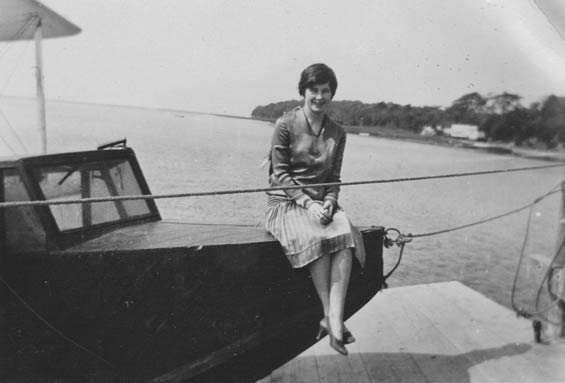 |
Below, two unidentified people.
Two Unidentified People, Ca. 1928-30 (Source: Barnes)
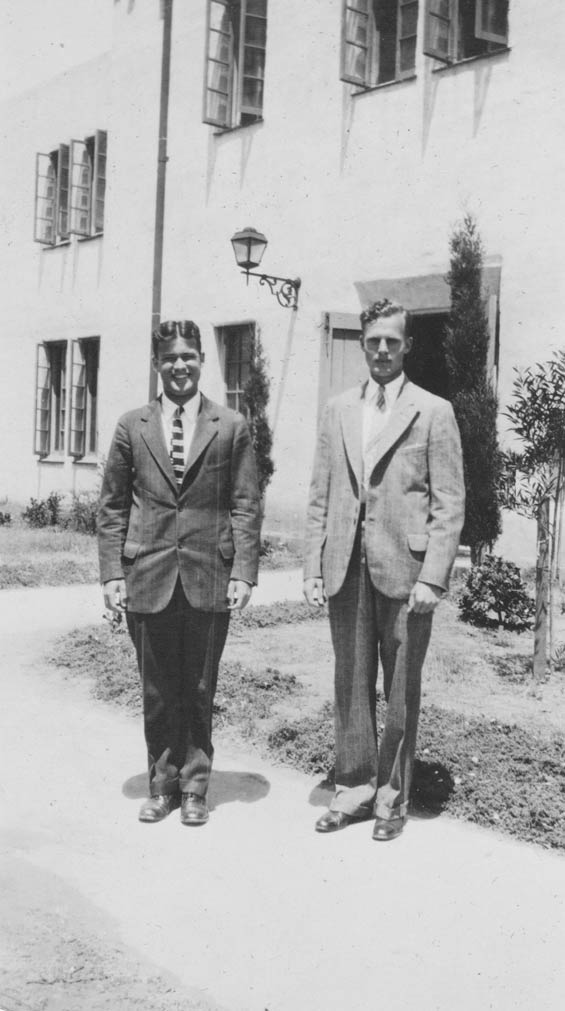 |
Below, a series of photographs which show McMullen's home in Coronado, CA when he was stationed at San Diego. The cars and the people are identified. Below, Harry (Sartoris) and Jack (Diffley). Upon magnification, both appear to be smoking pipes.
Harry & Jack, Coronado, Ca. 1928-30 (Source: Barnes)
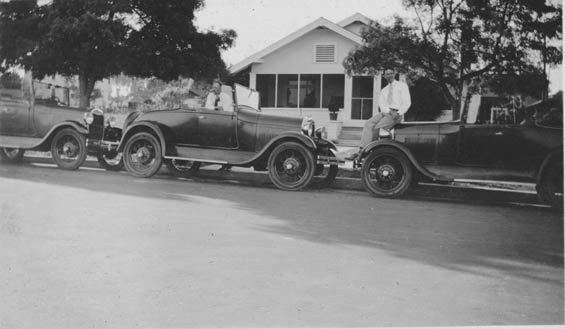 |
Caption for the above. These few photographs were developed November 13, 1929. Sensor Studio has no Web presence that I could find.
Harry & Jack, Coronado, Caption, Ca. 1928-30 (Source: Barnes)
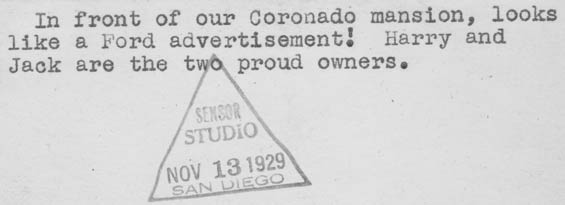 |
The automobiles appear to be 1928 Model A Roadsters ($385 new). Below, another view of them from the other direction. Jack and Harry (L to R) are still in the scene. McMullen's machine is on the right.
Three Fords, Coronado, Ca. 1928-30 (Source: Barnes)
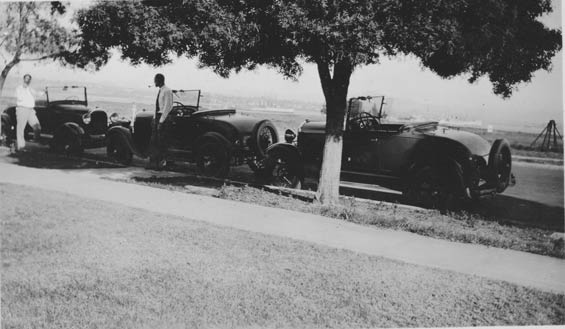 |
Below, caption for the above photograph.
Three Fords, Coronado, Caption, Ca. 1928-30 (Source: Barnes)
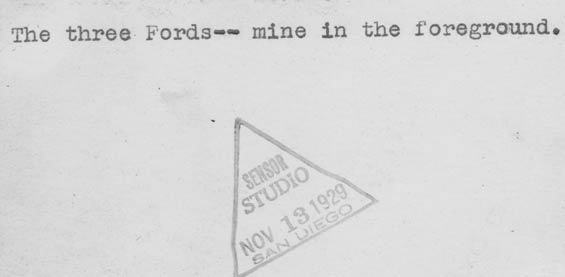 |
Below Jack and McMullen (R) at ease on the stoop of their Coronado home. Note the rocking chairs on the porch. Life was good for these squadron mates.
Jack & McMullen (R), Coronado, Ca. 1928-30 (Source: Barnes)
 |
The caption for the above photograph.
Jack & McMullen (R), Coronado, Caption, Ca. 1928-30 (Source: Barnes)
 |
Below, a group of tourists sightseeing at Mount Helix, northeast of San Diego. Mount Helix Park, which still exists, affords views of San Diego and environs. Upon close examination of this photograph, the topmost gentleman holds binoculars in his right hand and carries a fold-up bellows camera under his left arm. The left-most appears to be Jack as identified in the photos above. The man sitting appears to be Harry Sartoris.
Tourists, Point of Interest, Ca. 1928-30 (Source: Barnes)
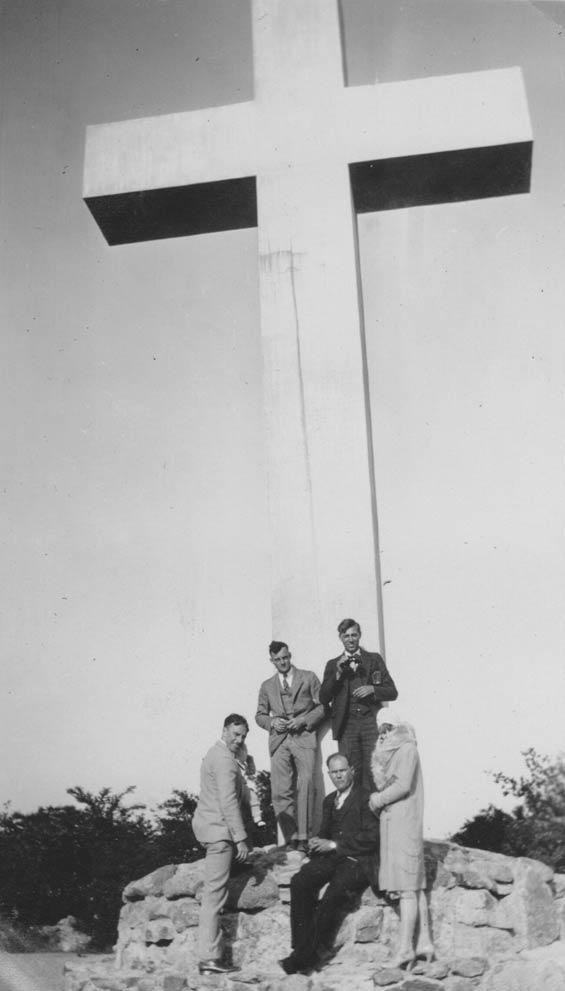 |
Two more photographs of sightseeing. Upon magnification, the license number on the car looks like 179635.
Point of Interest, Ca. 1928-30 (Source: Barnes)
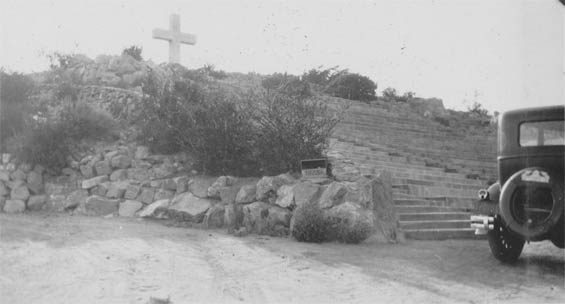 |
Below, McMullen holds Kewpie, Jr. on Mt. Helix.
McMullen and Fellow Pilot's Son, Ca. 1928-30 (Source: Barnes)
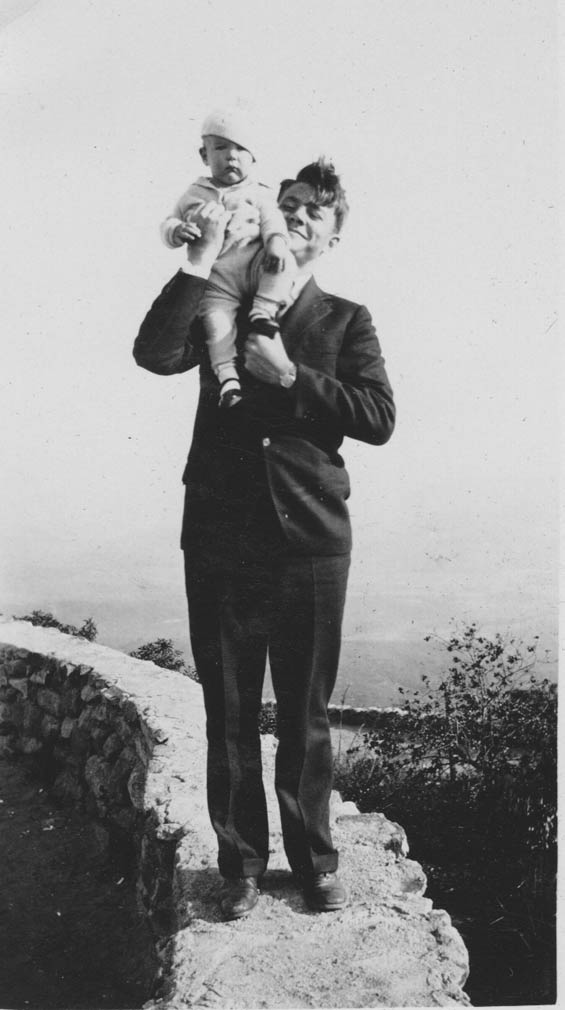 |
Caption for the photograph above.
McMullen and Fellow Pilot's Son, Caption, Ca. 1928-30 (Source: Barnes)
 |
The photo below seems to have been taken from another automobile (note the door jamb and seatback out of focus near the bottom of the shot).
Point of Interest, Ca. 1928-30 (Source: Barnes)
 |
Below, a photograph captioned by hand on the back, "The dude ranch in the mountains." A water tower is visible on the hill to the right, and a lone rider is visible in the clearing in front of the barn at far left. The road is dirt.
"The dude ranch in the mountains." Ca. 1928-30 (Source: Barnes)
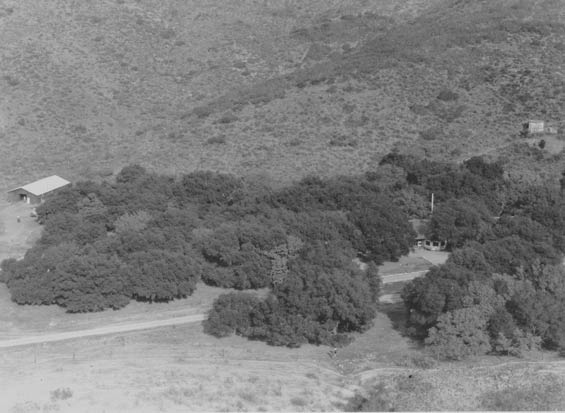 |
McMulllen peacefully (or posed) asleep in what appears to be a hospital bed with a thin mattress and woven wire spring. I have no information about an illness that he had that might have hospitalized him. The only thing that might have caused a brief hospitalization was the water landing he made after his airplane suffered engine trouble off the beach at San Diego. This landing is alluded to in his obituary listed at his biography page.
McMullen in Hospital Bed (?), Ca. 1928-30 (Source: Barnes)
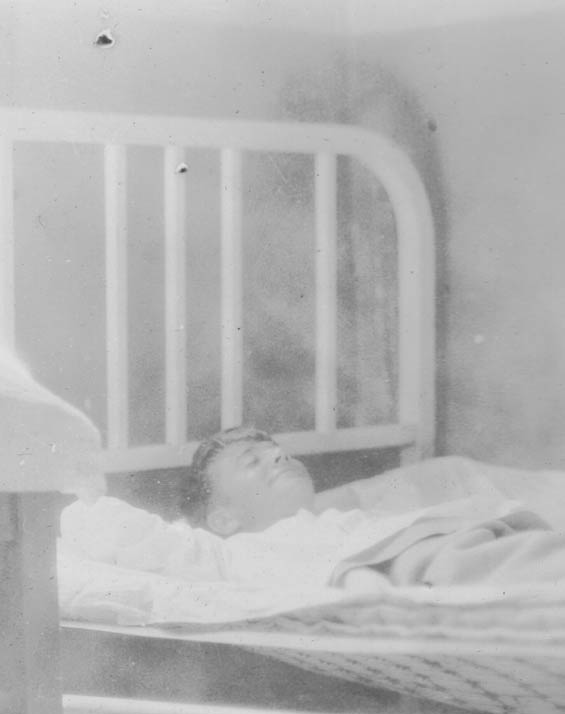 |
Likewise, I have no information about any relationship McMullen might have had with women. The following may have been platonic relationships or not. These are photographs of two young women from his Collection. The first eighteen photos are of woman number one. The first has McMullen and the woman in bathing suits and focuses interest on the contents of a hand-tooled leather purse.
W. H. McMullen & Unidentified Woman, Ca. 1928-30 (Source: Barnes)
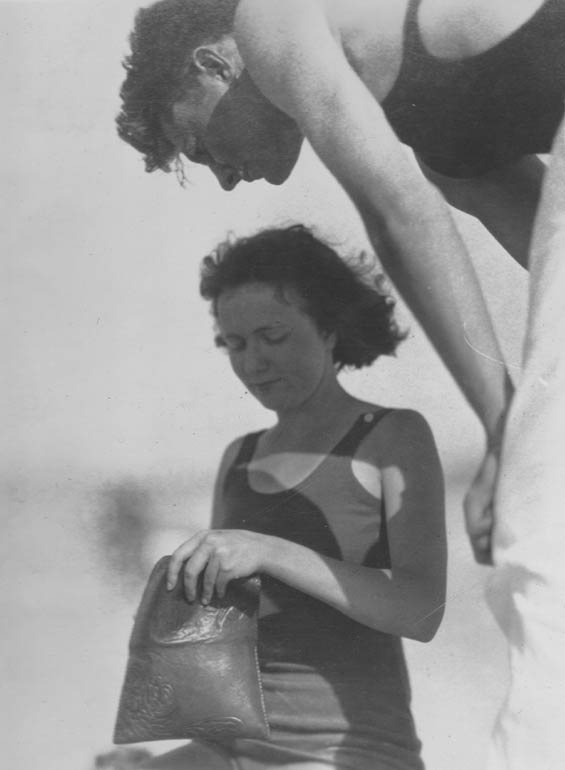 |
The following group are snapshots taken at a beach, with McMullen probably serving as photographer for most of them.
Beach Snapshots, Ca. Summer, 1929 (Source: Barnes)
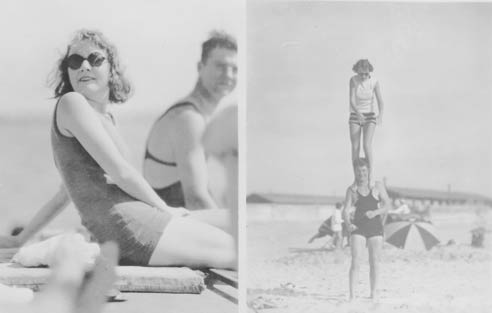 |
Beach Snapshots, Ca. Summer, 1929 (Source: Barnes)
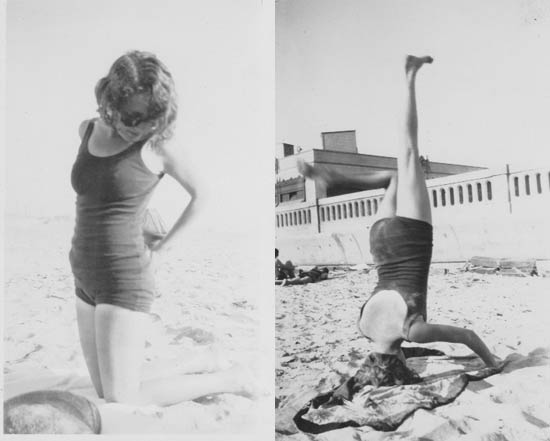 |
Beach Snapshots, Ca. Summer, 1929 (Source: Barnes)
 |
Beach Snapshots, Ca. Summer, 1929 (Source: Barnes)
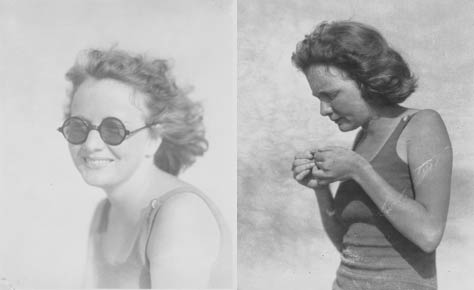 |
Beach Snapshots, Ca. Summer, 1929 (Source: Barnes)
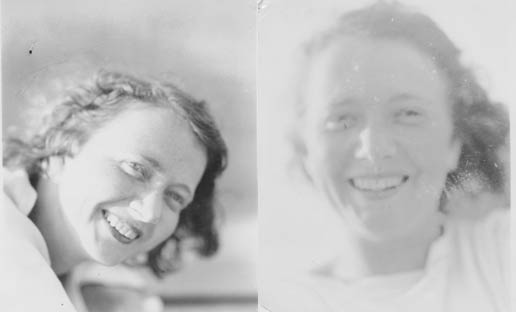 |
Beach Snapshots, Ca. Summer, 1929 (Source: Barnes)
 |
Ocean Front, San Diego (Source: Barnes)
 |
Although not exactly identical, Mr. Barnes speculates that the light pole in the photograph below resembles those installed at the contemporary boardwalk at Mission Beach, San Diego (photo, left). The geometry of the concrete balustrade is also similar.
Beach Snapshots, Ca. Summer, 1929 (Source: Barnes)
 |
Next has her posed wistfully against what looks like the shoulder of someone in dress whites (note what appears to be an epaulet near her ear).
Unidentified Woman, Ca. 1928-30 (Source: Barnes)
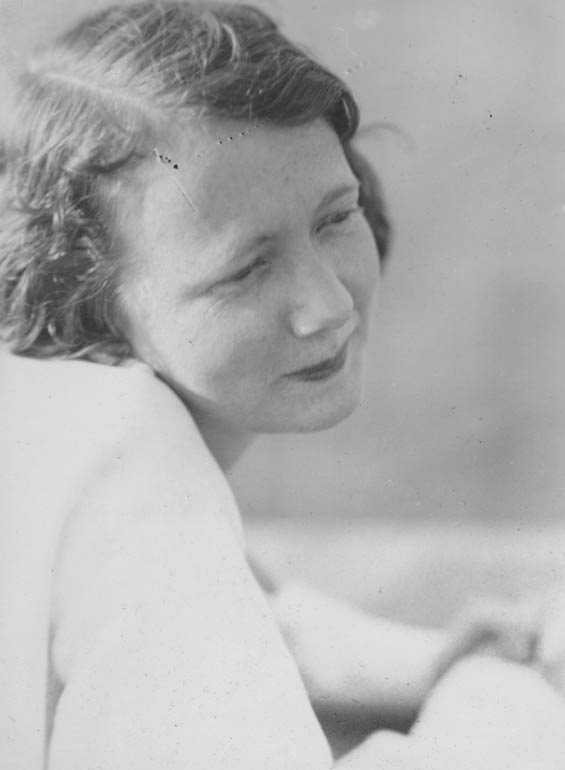 |
Next has her smiling pleasantly from the back seat of a touring car, perhaps the same one from which the photograph was taken of the gentleman in the other car above.
Unidentified Woman, Ca. 1928-30 (Source: Barnes)
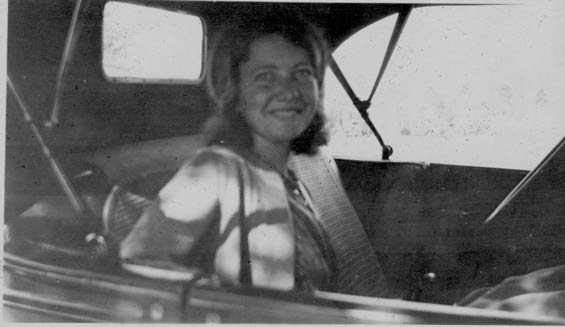 |
Next, she poses smartly in a dress in front of a tree.
Unidentified Woman, Ca. 1928-30 (Source: Barnes)
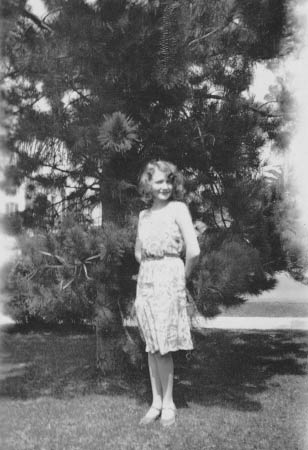 |
The final one has her posed in a suit holding her hat.
Woman Posing in Dress With Hat, Ca. 1928-30 (Source: Barnes)
 |
The caption on the back of the photograph above would cheer any young Golden Age naval aviator if he was unaware of the beach snapshots preceding. Note this photograph was printed November 13, 1929, about three months to the day before McMullen's death.
Woman Posing in Dress With Hat, Caption, Ca. 1928-30 (Source: Barnes)
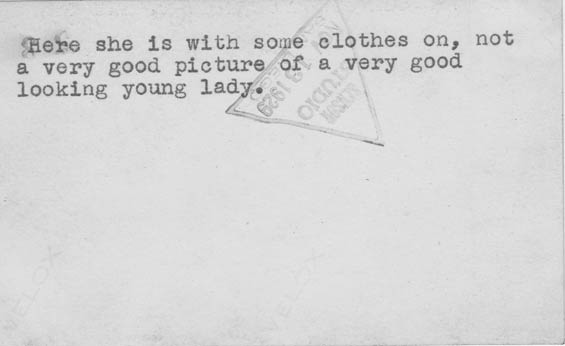 |
The second woman poses with a cabriolet. One could make the argument that she looks a little like McMullen's sister shown above.
Woman Posing By Cabriolet, Ca. 1928-30 (Source: Barnes)
 |
The same woman, full-length portrait.
Woman Posing in Dress & Hat, Ca. 1928-30 (Source: Barnes)
 |
Same woman in bathing suit sitting on grass with a pair of slides in the foreground.
Woman Posing in Bathing Suit, Ca. 1928-30 (Source: Barnes)
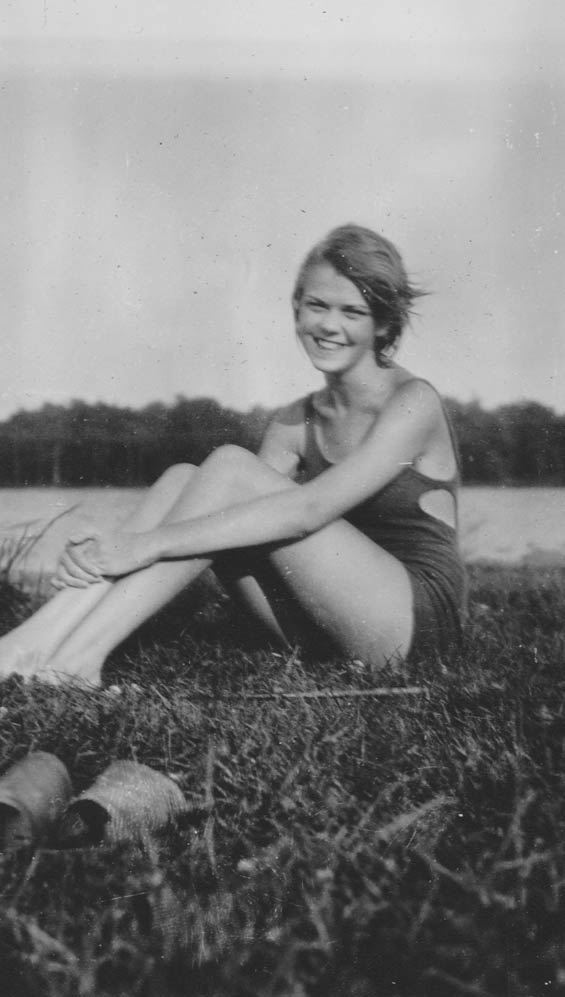 |
BACK TO TOP
---o0o---
---o0o--- ---o0o---
PHOTOGRAPHS IN PANAMA -- Twenty-four views. Most of these photographs are annotated by McMullen with nib pen on the front of the pictures.
Below, a token of the season in Panama is this Christmas Greeting from Patrol Squadron 9 for the 1929 holiday. It is signed by John R. Dickey (John R. Dickey graduated from the University of Michigan a couple of years ahead of McMullen). I could find no meaningful Web sources connecting John R. Dickey with Patrol Squadron 9. The history of the squadron before 1940 is also not well represented. I was able to learn that it was posted in Panama as late as 1939.
Christmas Greeting, Patrol Squadron 9, Panama, Ca. 1929-30 (Source: Barnes)
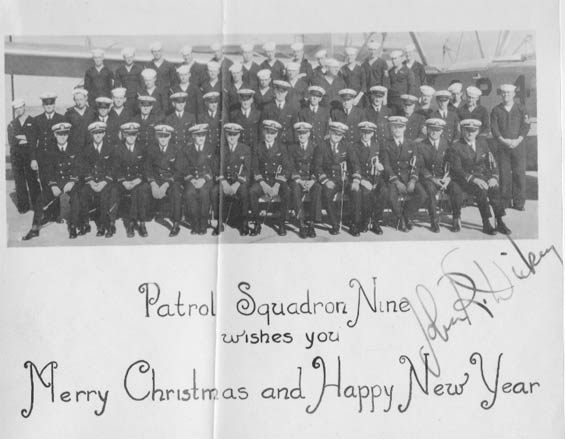 |
Below, the obverse of the greeting. A color photo of the insignia, ca. 1935, is at the Smithsonian. The flying goose was incorporated into the squadron insignia, "... because it is probably the most migratory of all birds, patrolling from the arctic to the temperate climates semi-annually. It travels with unerring judgment to its destination, displaying great endurance and speed; typifying the navigation necessary in patrol duties. It is noted for flying in formation, particularly the 'V,' analagous to patrol plane activities."
Christmas Greeting, Patrol Squadron 9, Obverse, Panama, Ca. 1929-30 (Source: Barnes)
 |
As 1930 approached, McMullen added some Panamanian photographs to his scrap book. Contributor Barnes states about these views, "He got his first Panama pictures developed; he got the Christmas card from the Patrol squadron member. But there are no pictures of Christmas in Panama."
He further states, "I had a very ominous feeling as the pictures focused on Panama. There are no pictures of the maneuvers of the planes attacking the aircraft carriers." That is probably because the photos below are the last ones McMullen had developed before his accident. Chances are good that if he did take photos of the maneuvers, his camera went into the Pacific with him and his airplane.
Boatload of Bananas, Panama, Ca. 1929-30 (Source: Barnes)
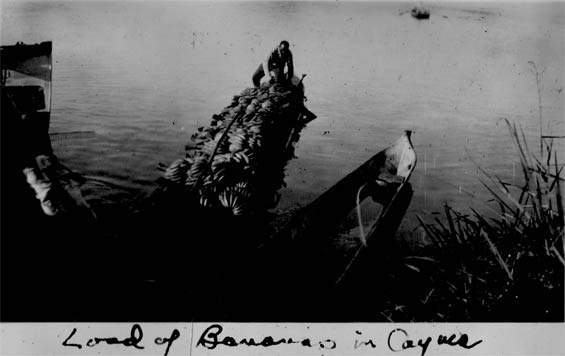 |
A village on the Chagres River.
Village on the Chagres, Panama, Ca. 1929-30 (Source: Barnes)
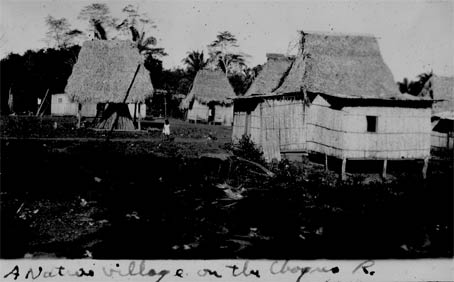 |
A village dock on the Chagres.
Village Dock on the Chagres, Panama, Ca. 1929-30 (Source: Barnes)
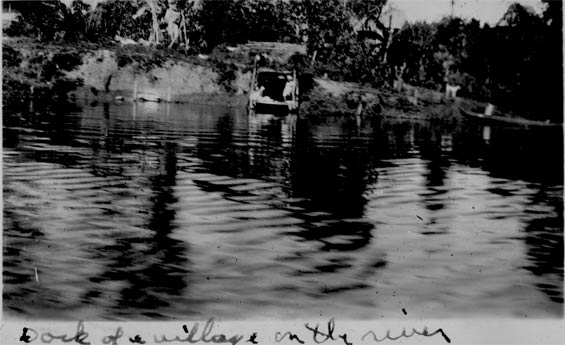 |
Another village with a reflection so perfect on the calm water that McMullen had to identify the top and bottom of his photograph.
Village Mirrored in the Chagres, Panama, Ca. 1929-30 (Source: Barnes)
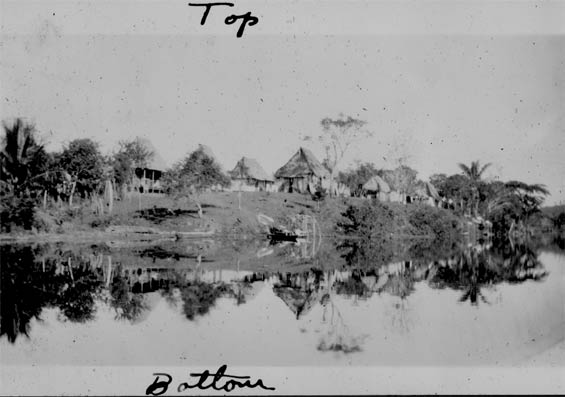 |
Another view of the river bank.
Chagres River, Panama, Ca. 1929-30 (Source: Barnes)
 |
McMullen penned on this photo, "Note the elbow and pole of the native standing in bow. Tour Cayuca."
Tour, Chagres River, Panama, Ca. 1929-30 (Source: Barnes)
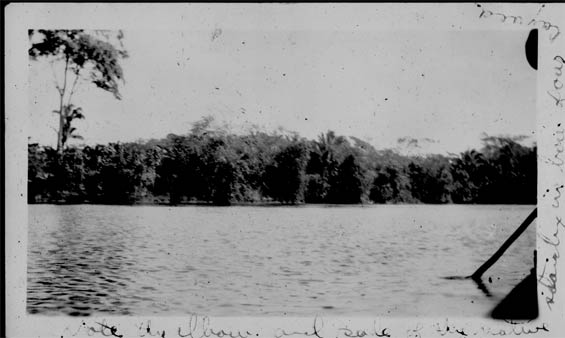 |
Below, some of the ensigns pictured above, only with different uniforms. McMullen identifes them as Kewpie Kimpler, Frank Kern, Ted Fredericks and Jack Diffley. He further writes up the side of the photo, "Note the Colts," meaning the sidearm automatic pistols they wear in holsters. At least 3 of them have been issued guns and gunbelts.
Four Ensigns, Panama, Ca. 1929-30 (Source: Barnes)
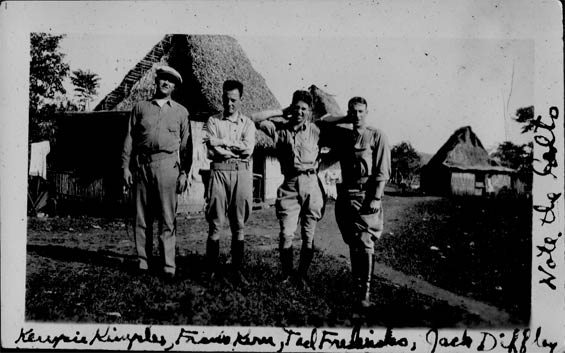 |
A train trip along the Panama Canal route allowed the following view of the lock control house and mechanism in the distance.
Panama Canal Locks, Panama, Ca. 1929-30 (Source: Barnes)
 |
A view of the Culebra Cut from shipboard.
Culebra Cut, Panama, Ca. 1929-30 (Source: Barnes)
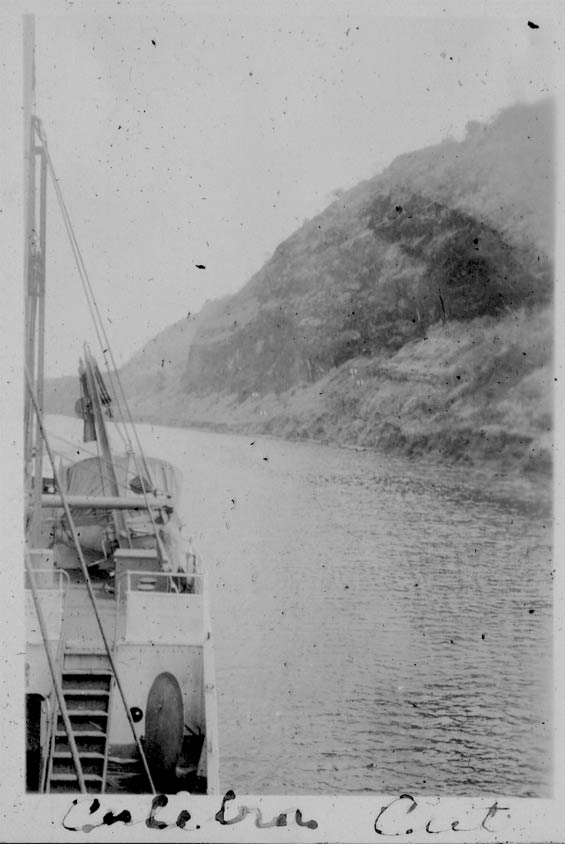 |
Passing another ship in the Panama Canal.
Passing a Ship in the Canal, Panama, Ca. 1929-30 (Source: Barnes)
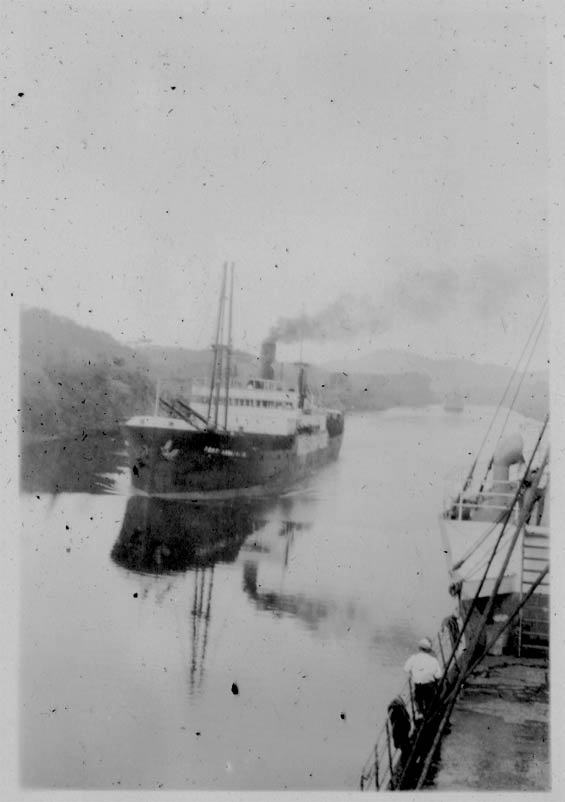 |
Below, a dock scene with shoreboat operations. Note the men in fedoras.
Panama, Dock Scene, Ca. 1929-30 (Source: Barnes)
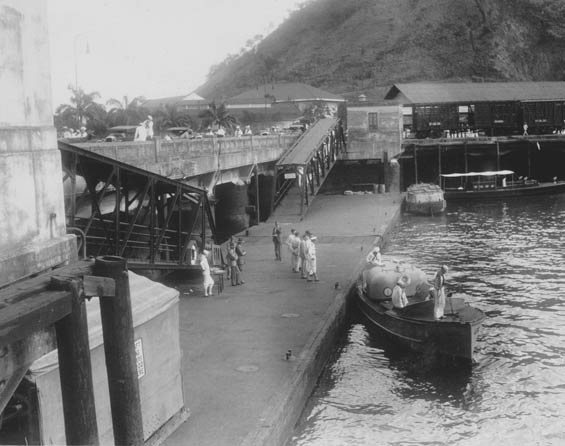 |
Next, a street scene from Panama City. Does anyone RECOGNIZE the street?
Panama, Street Scene, Ca. 1929-30 (Source: Barnes)
 |
Below, a street scene from a postcard in McMullen's album. The street is identified as Central Avenue, Panama City.
Panama, Street Scene, Ca. 1929-30 (Source: Barnes)
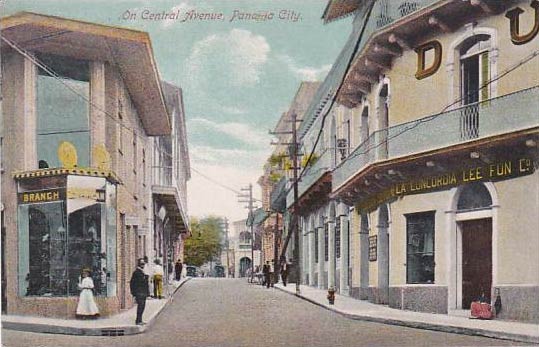 |
Below, McMullen and friends visited the ruins of the convent in old Panama. Almost the same photograph is at the link. The linked photograph probably predates McMullen's. Note the fallen tree at left, below, which appears thicker than the one standing in the same place at the link. Note also that McMullen stood farther to the left to make his photo than the photographer did at the link.
Old Convent, Panama, Ca. 1929-30 (Source: Barnes)
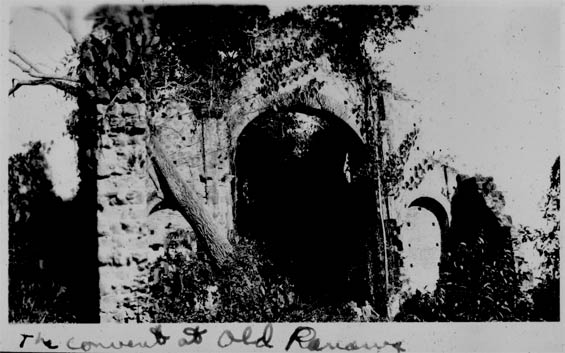 |
Unidentified ensigns stand in shadows at the convent ruins now penetrated by cracks noted by McMullen.
Old Convent, Panama, Ca. 1929-30 (Source: Barnes)
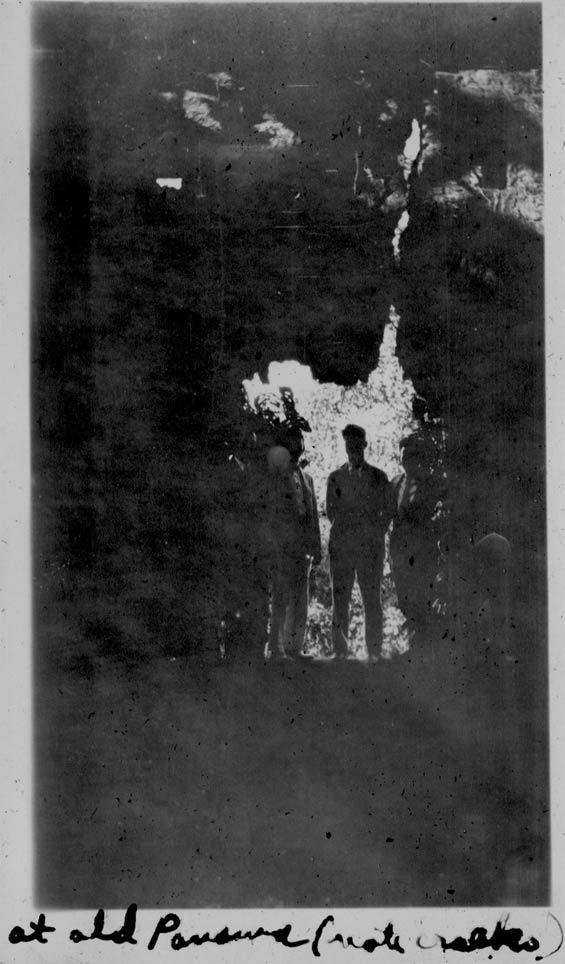 |
Ensigns pose at a breach in the convent wall. McMullen identifies them as Frank Kern, Tom VanStone, Harry Sartoris, Walt (?) and himself. Kern and VanStone hold cigarettes.
Old Convent, Panama, Ca. 1929-30 (Source: Barnes)
 |
Below, McMullen admits to jiggling the camera for this view.
Old Convent, Panama, Ca. 1929-30 (Source: Barnes)
 |
The cathedral tower at the convent.
Old Convent, Panama, Ca. 1929-30 (Source: Barnes)
 |
McMullen notes below, "Looking up inside the tower. They found $100,000 of jewels etc. up there about 3 years ago."
Old Convent, Panama, Ca. 1929-30 (Source: Barnes)
 |
A tree grows out of the ruined wall.
Old Convent, Panama, Ca. 1929-30 (Source: Barnes)
 |
McMullen postulates the reasons for holes in the wall.
Old Convent, Panama, Ca. 1929-30 (Source: Barnes)
 |
Finally, below, a portrait of McMullen, probably checking last-minute cockpit details. Note the gunsight in front of him. Heads-Up-Displays were still a long way off. Alas, McMullen would never see them, or the other advancements to come in air and space.
W. H. McMullen, Ca. 1928-30 (Source: Barnes)
 |
Contributor Barnes says, "What a tribute to this naval aviator who died so young. [My aunt] never knew William Hyde McMullen, the naval aviator, as she met and married his brother 9 years afterwards. However, they named their son, William Hyde McMullen."
BACK TO TOP
---o0o---
---o0o--- ---o0o---
---o0o---
THIS PAGE UPLOADED: 03/28/12 REVISED: 04/02/12, 04/29/12, 05/13/14, 09/07/16
|

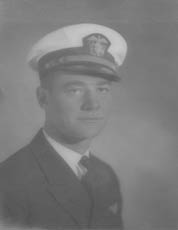



































































































.jpg)
























































































































































